- BOAT OF THE YEAR
- Newsletters
- Sailboat Reviews
- Boating Safety
- Sailing Totem
- Charter Resources
- Destinations
- Galley Recipes
- Living Aboard
- Sails and Rigging
- Maintenance


The Return of l’Hydroptere
- By Ronnie Simpson
- Updated: August 2, 2021
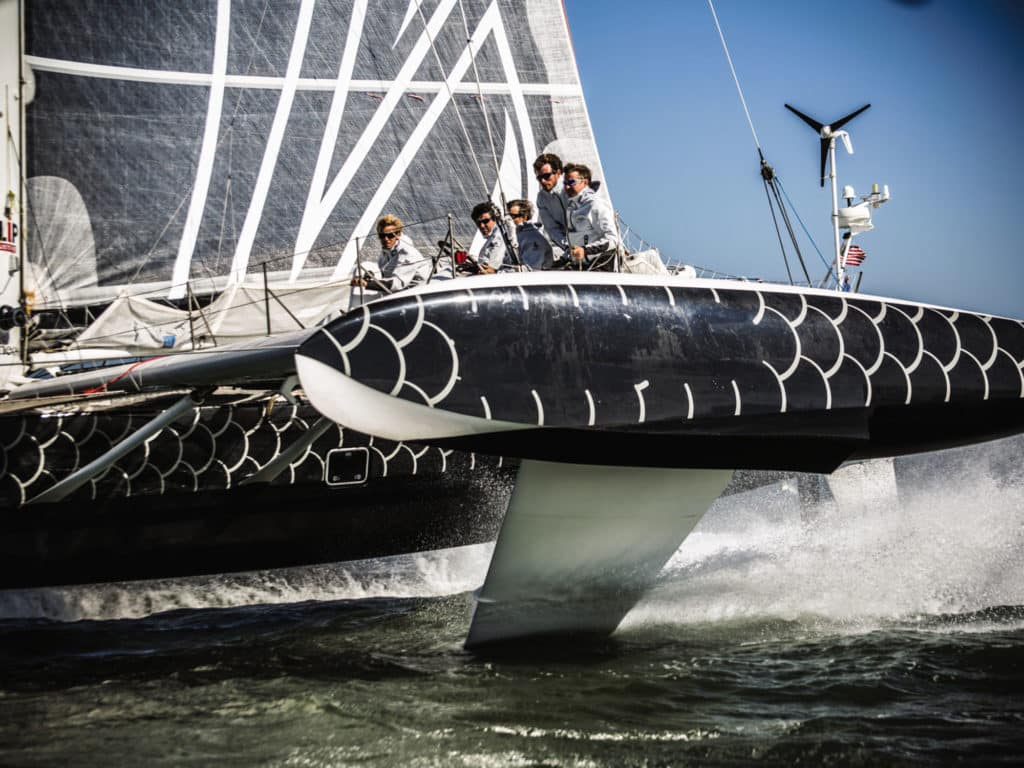
In the sport of sailing in 2021, foiling is all the rage and has completely revolutionized our game. Catamarans have been foiling in the America’s Cup for nearly a decade and have since spawned an entirely new breed of foiling monohull . Partially as a result of these unprecedented investments in foiling technology, the trickle-down has been rapid, widespread and eminently consequential. From the explosion of the foiling Moth dinghy and foiling beach cats and monohulls to the adaptation of hydrofoils on everything from surfboards and SUPs to Vendée Globe solo offshore rockets, kiteboards, and one-design racers—and even some cruising yachts—foiling has touched every aspect of yacht design. However, long before foiling went mainstream, there was one famous French foiling trimaran blazing its own bold path well above the ocean’s surface: l’Hydroptère .
The History
When the 60-foot l’Hydroptère was originally conceived in the 1970s, she more closely resembled a far-fetched futuristic concept of what a racing sailboat might one day look like than an actual boat. Compared with the heavy-displacement keelboats of the day, l’Hydroptère appeared to be something off the TV show The Jetsons . Conceived by the godfather of French offshore racing, Eric Tabarly, the initial concept of l’Hydroptère was simple. With wings riding under the water, the boat could achieve lift and then rise above its surface, thus greatly reducing the boat’s hydrodynamic drag while exponentially increasing its speed potential. Simply put, the idea was to marry sailing and flight; appropriately, l’Hydroptère ’s name is a combination of the Greek word hydros , for water, and the French term, ptère , for wing.
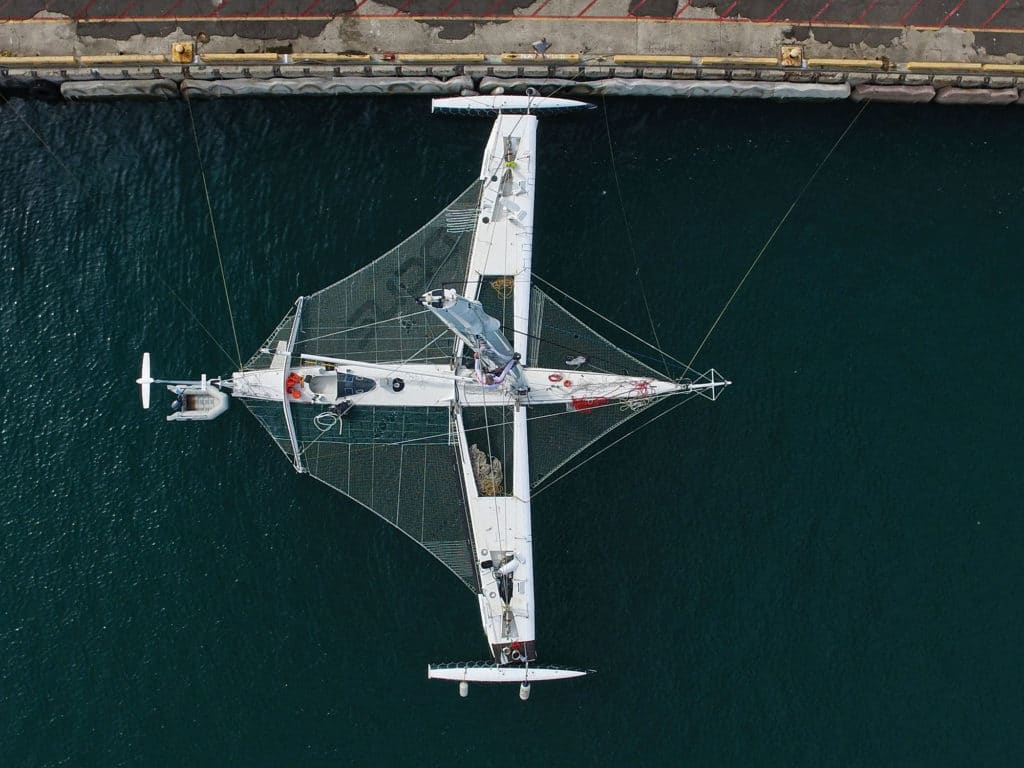
To pioneer the concept of a flying boat isn’t easy, and the many failures—and hard-earned victories—of l’Hydroptère are a testament to this fact. Working in conjunction with the now-dominant design firm VPLP and some of France’s top boatbuilders, project manager Alain Thébault, Tabarly and their collaborators worked through several evolutions of the basic l’Hydroptère concept before building the boat that would eventually crush world sailing speed records, inspire legions of sailors, and become the subject of sailing folklore.
After beginning with a simple wooden version of the concept in 1976 using a Tornado catamaran hull as the main central hull, by the mid-1980s, the team moved on to small, remote-controlled prototypes, followed by a one-man, one-third-scale flying boat by the early 1990s. In 1994, the dream literally took flight when a full-scale prototype was hovering well above the water off the coast of France. But in 1995, while sailing at close to 30 knots of boatspeed, l’Hydroptère suffered the structural failure of a port crossbeam and quickly crashed down to the water’s surface. Fortunately, the boat was salvaged and brought back to port.
Half a dozen years later, in 2001, the fourth and final iteration of l’Hydroptère was launched. Almost immediately after hitting the water, its increased speed potential was evident. In 2005, l’Hydroptère sailed across the English Channel at a sustained average speed of nearly 40 knots, eclipsing Louis Blériot’s first record for flying across the English Channel in an airplane in 1909. Two years later, in April 2007, l’Hydroptère sailed into the record books as the fastest sailboat over both 500 meters and 1 nautical mile, earning its first (but not last) World Sailing Speed Record.
To pioneer the concept of a flying boat isn’t easy, as the many early failures proved.
In December 2008, Thébault and his men peaked at more than 56 knots, briefly, before breaching l’Hydroptère ’s foils and then immediately pitchpoling into a capsize. Undaunted, the team came back in 2009 stronger than ever and set another World Sailing Speed Record, this time covering 500 meters at an average speed of more than 51.3 knots of boatspeed with a peak of nearly 59 knots; it was an incredible achievement, and marked the first time a boat officially crossed the near-mythical 50-knot barrier for a sustained period of time. Coincidentally, this 50-knot barrier represents the current speed limit for the America’s Cup and Sail GP catamarans. Any faster, and foil ventilation and cavitation begins to rear its ugly head.
Highs and Lows
Entering a new decade in 2010, Thébault and his men secured another injection of funding for an entirely new adventure. With one World Sailing Speed Record firmly in hand, tri now aimed toward an infinitely larger racetrack: the Pacific Ocean. In May 2012, the boat arrived in the port of Long Beach, California, on a container ship to undergo further optimization before embarking on an ambitious record attempt to sail some 2,215 miles to Honolulu, Hawaii. With consistent trade winds and the long, groomed swells of the Pacific, the Transpac Race course was identified as the best potential venue to prove the concept of flying across an ocean—a goal that l’Hydroptère ’s visionary, Tabarly, who had since passed away, had been pursuing since before the early 1980s when he sailed one of the world’s first ocean foilers, Paul Ricard , across the Atlantic and into the record books.
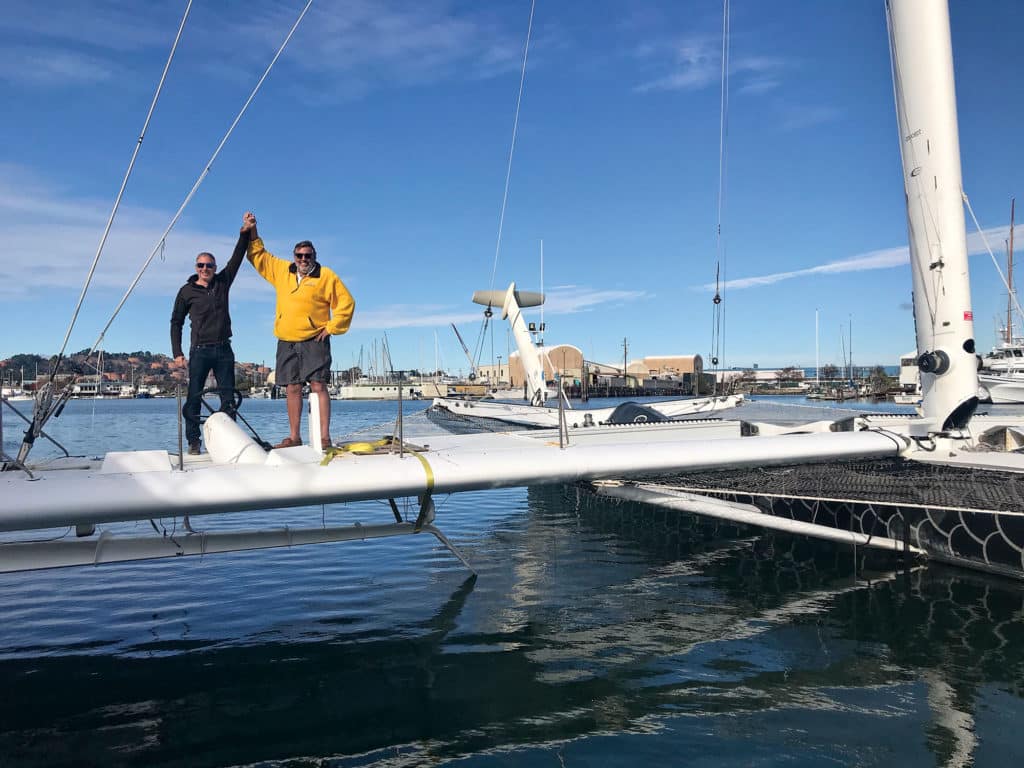
With a crew that included Vendée Globe legends Yves Parlier and Jean le Cam, as well as round-the-world multihull ace Jacques Vincent, l’Hydroptère was well-primed to fly to Hawaii in record time. Unfortunately, the 2012 record attempt was scrapped, and l’Hydroptère was instead moved to the San Francisco Bay area. On the hunt for sponsorship dollars there and in nearby Silicon Valley, l’Hydroptère began preparing for another assault on the Transpac course record the following year in 2013. The record, held by Frenchman Olivier de Kersauson and his crew on board the maxi-trimaran Geronimo, was set at just 4 days, 19 hours, 31 minutes, 37 seconds—certainly a very quick time to cover over 2,000 nautical miles, but it was well within the scope of a big, modern foiling trimaran.
However, the 2013 record attempt was also aborted. Perpetually strapped for cash and seemingly swimming against the tide in many respects, l’Hydroptère wouldn’t set sail for Hawaii until 2015. That year, with meager funds and their high-profile, rock-star sailors back in France, l’Hydroptère crossed the starting line with a crew of lesser-known, less-experienced sailors. Both the team and the weather window proved suboptimal. Attempting to run downwind in light air, this hydrofoiling reaching monster was relegated to drifting toward the islands at a relative snail’s pace, firmly stuck to the surface of the water. No foiling equals no fun. And certainly no speed record.
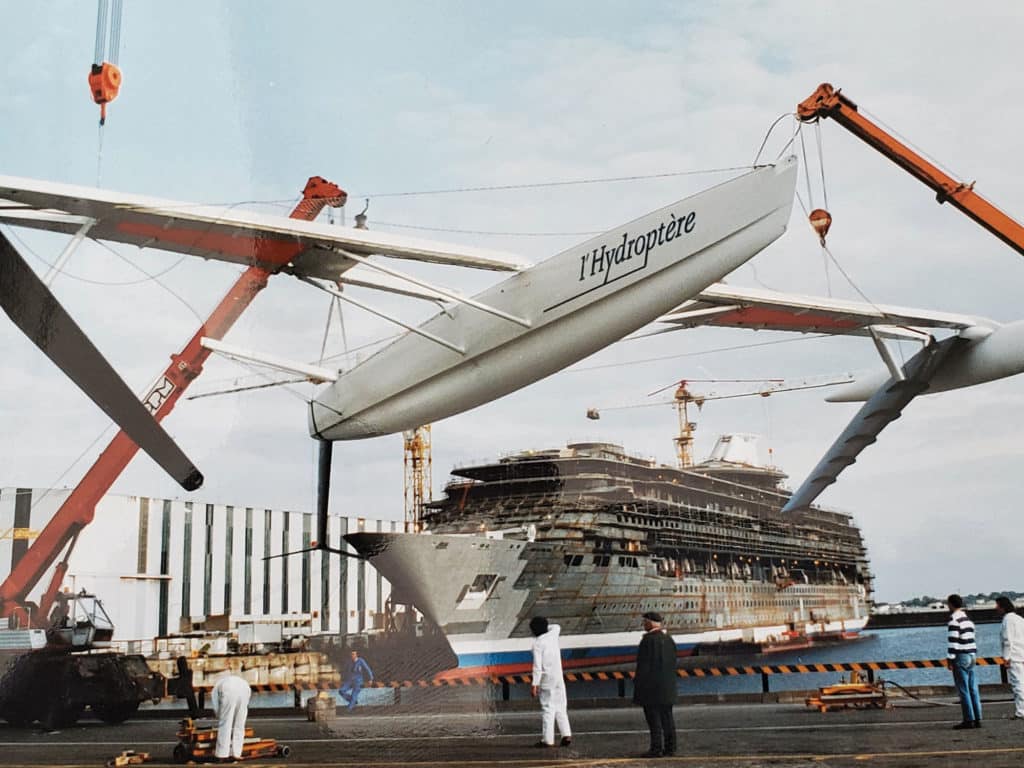
After an unsuccessful and embarrassingly slow Transpacific record attempt that took nearly 11 days—well over twice their goal— l’Hydroptère was left unceremoniously tied alongside a dock in Honolulu’s Kewalo Basin. The French program, already severely underfunded, eventually abandoned the tri in Hawaii. After a prolonged spell at Kewalo Basin, she was eventually moved to a state mooring ball in Keehi Lagoon. For most boats, this is akin to receiving a slowly implemented death sentence featuring no shortage of cruel and unusual punishment along the way.
Of all the seedy harbors in the state, perhaps no place is worse than the Keehi Lagoon mooring field. Located right beneath the flight path to the international airport, Keehi is loud, dusty, smelly and incessantly windy. Notorious for its derelict boats, floating meth labs and gross mismanagement, it’s a place where once-great boats go to die. Way in the back, just astern of the two submerged rigs of a sunken ketch, lay one of the fastest sailboats the world had ever seen, on its own downward spiral toward an ignominious death. To a passionate racing and cruising sailor like me, this was about as sad as it gets
No doubt about it, l’Hydroptère had hit rock bottom. Which meant there was only one way to go: up.
The Dream Renewed
For l’Hydroptère to be rescued and resurrected at this juncture, a savior was required. Luckily for the down-and-out vessel, not one but two such souls miraculously appeared.
“I had first seen l’Hydroptère several years earlier in Southern California while preparing for a Transpac race, and she certainly piqued my curiosity,” says Chris Welsh of Point Richmond, California. In June 2019, the abandoned l’Hydroptère went up for public auction, and Welsh was on an airplane to Honolulu to look her over more closely and place a bid on the boat. Owner of the Spencer 65 Ragtime— a veteran of more Transpacs than any other boat in history, and not coincidentally purchased from a police auction—Welsh had some history with massive multihulls as well. He owned Steve Fossett’s old maxi-catamaran Playstation , which had been converted to a powerboat named Cheyenne . Welsh clearly wasn’t afraid to take on an ambitious project with a famous and historic old boat. A prominent West Coast yachtsman who also owns Point Richmond’s commercial Sugar Dock marina, Welsh had both the resources and the vision to bring a boat like l’Hydroptère back to life.
But he wasn’t the only one.
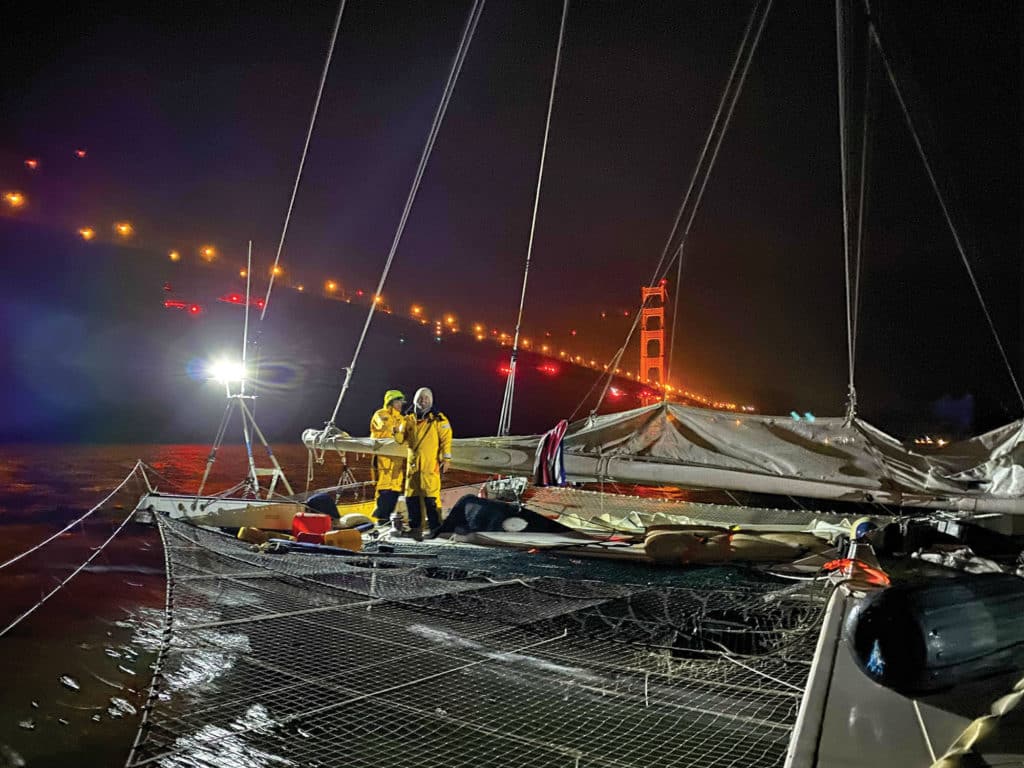
“It was always in my heart to follow this boat,” Frenchman Gabriel Terrasse says. “I had discovered l’Hydroptère at the Paris Boat Show in 1998, and then I went on the internet to learn more and I could not find anything, so I built a website about the boat. A few months later, the l’Hydroptère team had me build their official web page.” Fast-forward nearly two decades, and Gabriel’s interest in the boat had not dwindled. “In 2016, when the boat was first abandoned and for sale in Honolulu, I thought to buy her, but I was not quick enough. I knew l’Hydroptère had more inside her, more to accomplish, so when I heard that the boat was up for auction in 2019, I flew to Honolulu to buy her.”
The big tri was abandoned in a seedy harbor, on a sad, downward spiral toward death.
The two competing bidders met the night before the auction. “That is when I first met Gabriel,” Welsh says. “We were both there to buy l’Hydroptère . After talking, we shook hands and decided to team up.” This would prove to be the beginning of a very special, if unlikely, friendship. Welsh says, “With my yard in the Bay Area, it would just be so much easier and cheaper to refit the boat there, so we figured out what she needed to make the trip, hired a delivery captain, and then spent most of the summer getting the boat ready to sail back to San Francisco.”
A professional racing sailor on the West Coast, Hawaii and Asia, Mike Price was the delivery skipper tasked with getting l’Hydroptère back across the Pacific. “ At its worst, l’Hydroptère was in very poor shape,” he recalls. “The coffee grinders had been stripped, the clutches and winches were removed, and the steering system, which was hydraulic, was ripped apart on one side but left intact on the other. Someone had bashed in the entry hatch and stolen the chart plotter, GPS and electronics. They left in place most of the hydraulics for the flight-control systems, but the sails and everything else were gone.”
A lesser sailor might’ve walked away, but even in her dilapidated condition, for Price, the sheer brilliance of l’Hydroptère shone through. “Structurally, the boat was very well-intact,” he says. “The hull was built a long time ago, and it was uncharacteristically overbuilt out of carbon. There were no breaks or cracks in the laminate or between structures. Being made completely out of carbon and titanium, everything seemed very solid. The mast and the standing rigging looked fine.”
Even so, before embarking on the trip to California, l’Hydroptère underwent a Honolulu refit that included a new diesel engine, some cobbled-together delivery sails, fresh deck hardware and winches, new backstays, and a lot of new lashings for the sail controls and rigging.
Then, Price says, “we brought a ton of diesel fuel, lashed it down everywhere we could find room, and left on the most benign weather window that presented itself. We had very flat seas and light air for the first 800 miles. We motored for six days at 5 to 6 knots, and it was nice for most of the passage. But it’s a very wet boat! At some point, every piece of electronics crapped out and had to be rewired at sea. The most wind that we ever saw was 25 knots, and we sailed the boat super conservatively with the foils all the way decambered to keep l’Hydroptère firmly in nonfoiling mode. We cruised under jib only when it was windy and made the passage in good shape. But it was something like science fiction, man. What a cool boat!”
Shortly after the boat returned to California, the COVID-19 pandemic brought much of the world to a halt, though this would prove to be a blessing in disguise for the newly reassembled l’Hydroptère team. “It was strangely good fortune that we ended up with five people all stuck together for 90 days,” Welsh says. “We got a lot done because we didn’t have a lot of distractions, so we just made the most of it. We cleaned up the boat and got everything out of it. It needed to be disassembled in a way that you could inventory the condition of things and restore them before putting it back together. In doing so, we were pleasantly surprised that the boat had survived the sun in Hawaii better than we expected.” Unfortunately, due to visa restrictions, Terrasse had to return to France, where he’s pursued new technical partners.
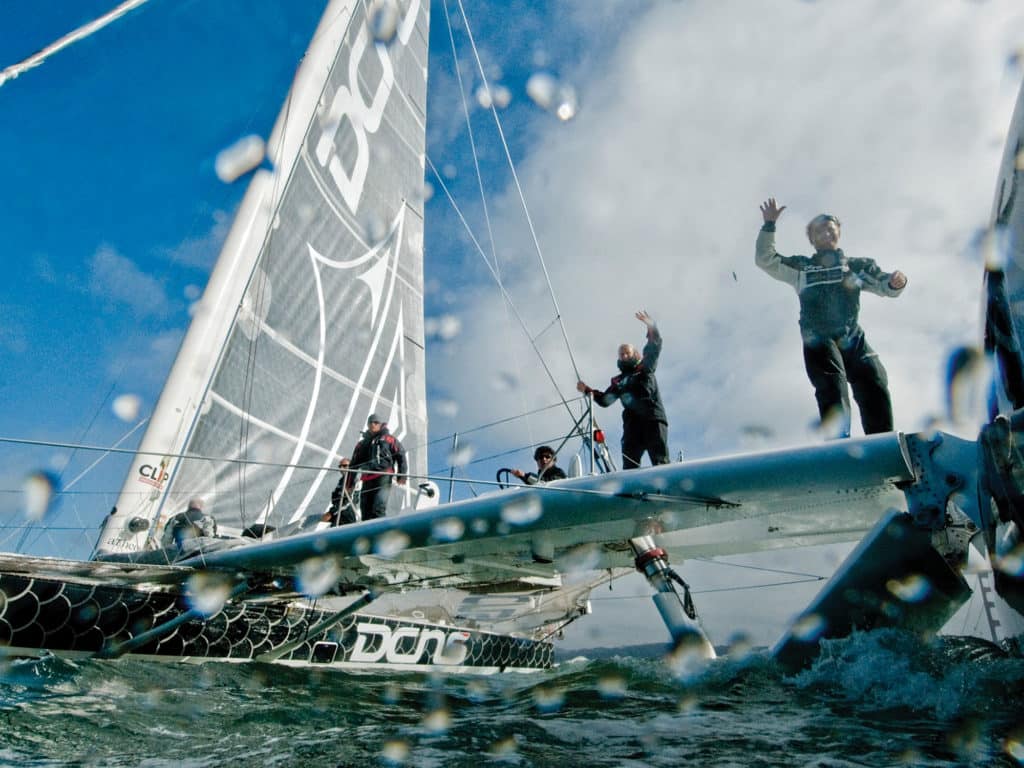
“ L’Hydroptère is a big, tough boat,” Welsh says of the vessel he’s still learning about. “She is not some delicate wallflower that takes 25 guys to run. She was solidly constructed out of carbon and titanium, and is built for real sailing. She’s strong enough to try other foils, and there are some clear pathways to making her lighter. And l’Hydroptère is an interesting platform to move forward with, and there is still potential for some record breaking, particularly with point-to-point passages.”
Likewise, Terrasse insists that there is a lot more left in l’Hydroptère ’s tank and that there remains a world of possibility. “We want to make her fly again,” he says. “To improve her. I’m working on the R&D to make her faster, with new technology. L’Hydroptère was built with 20-year-old technology. With rigid sails (a wing), with new foils for higher speeds, with more weight reduction…. There is a long list of possibilities. We have a big wish list. It is a nice and crazy project!”
Sailors are, by nature, dreamers. It’s one of the qualities that makes this sport so beautiful and keeps us all coming back. As well, the boats themselves, and the adventures that those vessels have inspired, have an uncanny ability to bring people together. From the forward-thinking sailors and engineers who first dreamed up this magnificent flying boat nearly 50 years ago to the unlikely cast of characters who are today bringing it back to life in Northern California and in France, l’Hydroptère has inspired legions of sailing fans for decades and continues to do so to this day. In a world in need of some good news right now, the unlikely renaissance of the world’s first famous flying boat—and the new bridges that have been built as a result—continue to remind us that anything is possible. What will l’Hydroptère ’s next chapter bring? We don’t know. But we can’t wait to find out.
Offshore cruiser and racer Ronnie Simpson is a CW contributing editor.
- More: multihull , multihulls , print June 2021 , Sailboats , trimaran
- More Sailboats
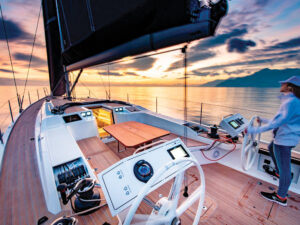
Sailboat Review: Italia Yachts 14.98
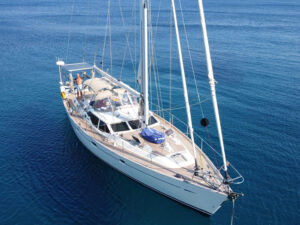
For Sale: 2000 Oyster 53
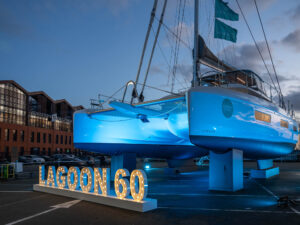
Lagoon 60 Prepares for World Premiere
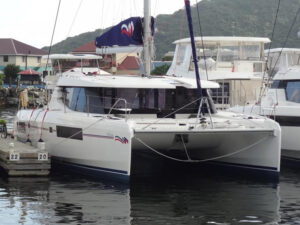
Now For Sale: Leopard 45
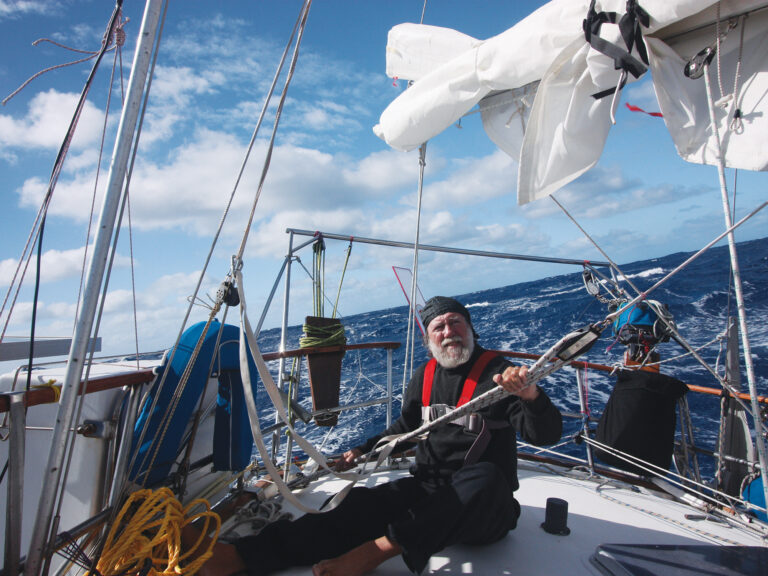
Learning the Art of Seamanship
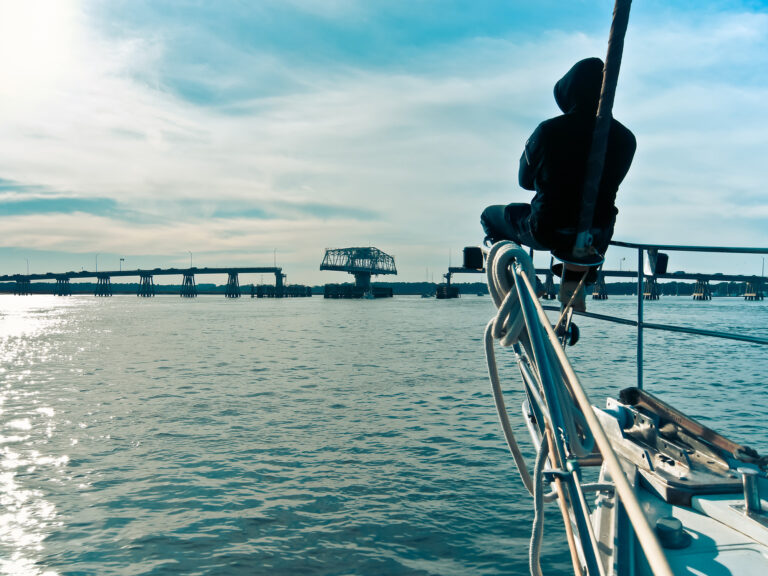
ICW Boaters Will Benefit from $48.5M Dredging Funding
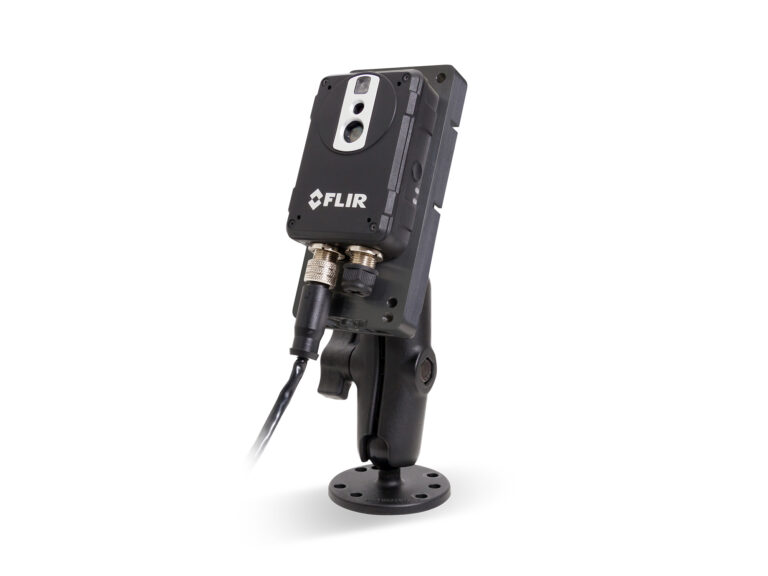
FLIR Announces Garmin Integration of Maritime Thermal Monitoring
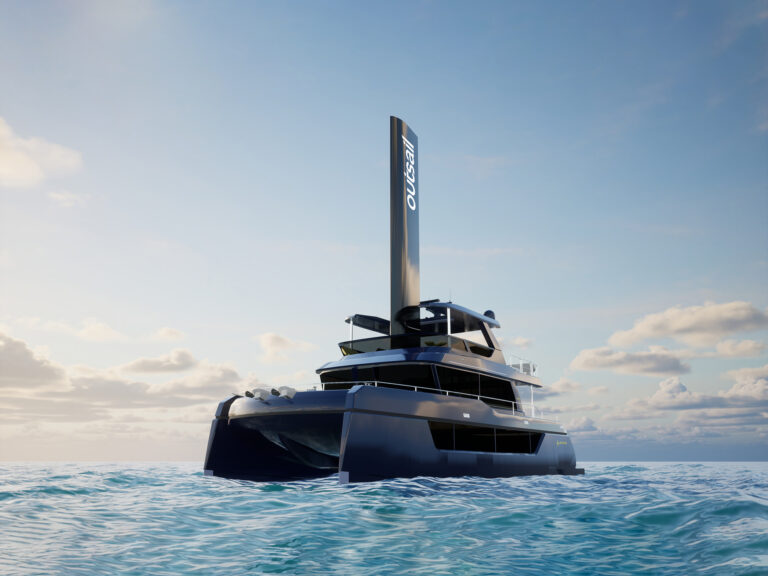
Invention on the Breeze
- Digital Edition
- Customer Service
- Privacy Policy
- Email Newsletters
- Cruising World
- Sailing World
- Salt Water Sportsman
- Sport Fishing
- Wakeboarding
BoatNews.com
The key dates of the Hydroptère, the trimaran flying with an impressive career
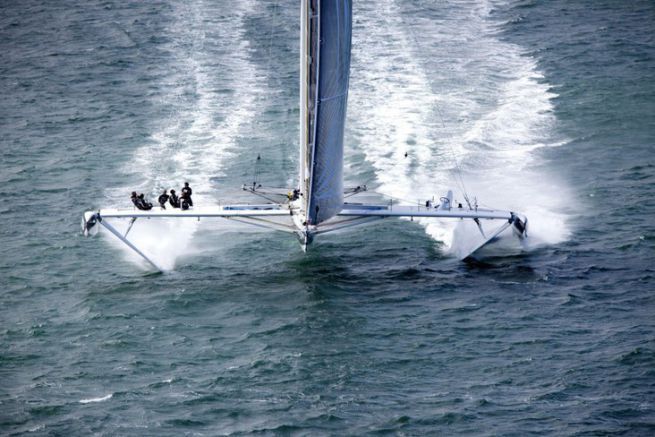
With more than 25 years of skimming the water in the most magical way possible: by flying, the Hydroptère has left its mark on the minds of sail lovers and many French neophytes alike. Here is a summary of his story that began with an idea that sprang up in Eric Tabarly's mind.
L'Hydroptère is a trimaran flying on 2 huge foils installed under the floats and a lifting plane on the rudder. Entirely built in carbon sandwich, this sailboat weighs about 7 tons. It uses landing gear shock absorbers from the Rafale aircraft to absorb the forces on the foils. Measuring 18.24 m long (60 feet), it is its width which is impressive with 24.50 m between the 2 small floats.
Many people worked on the construction of this yacht, including the naval architecture firm VPLP and engineers from various major aeronautics companies (Dassaut, EADS, DCNS in particular).
Imagined more than 40 years ago and launched 25 years ago, the Hydrofoil has left its mark on the minds of many sailors through the incredible images of high-speed runs. This very long nautical career does not seem to be over since l'Hydroptère has just been bought at the end of 2019 by owners who want to relaunch a record campaign.
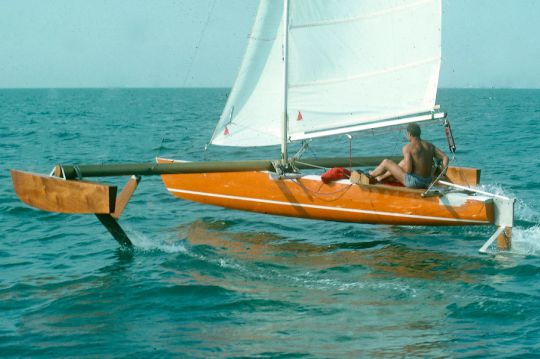
Eric Tarbarly flies on a trimaran made from the hull of a Tornado. These trials are taking place in La Rochelle .
Alain Thébault, a young disciple of Tabarly with whom he sailed (he was 22 years old at the time), took over the project and sought funding by getting closer to Dassault. The first drawings of what will be the Hydrofoil are beginning to emerge.
A 1/3 scale model is built to validate the concept
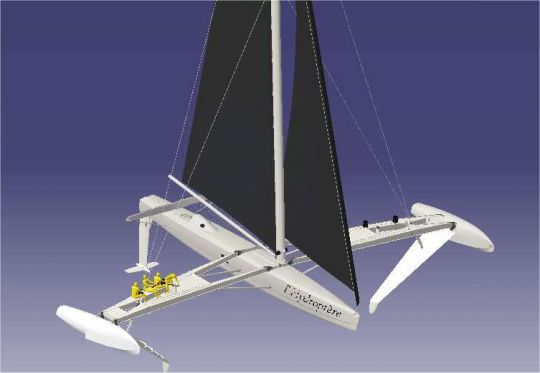
Launch of l'Hydroptère and first tests. The machine reaches a speed of 35 knots which is promising for the future.
Éric Tabarly, 20 years after his first thoughts on flying sailboats, takes off with l'Hydroptère.
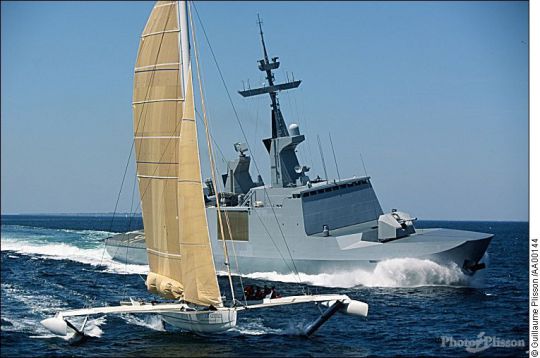
During a video session, aboard the French army frigate Surcouf, the Hydroptère breaks its port link arm.
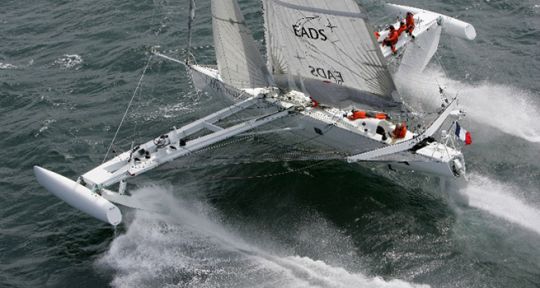
Then in its 4th development version and supported by Alstom, on 9 February, l'Hydroptère set the record for crossing the English Channel under sail in 33 minutes. Two minutes less than Louis Blériot's first plane crossing. On this crossing, the average speed will be 33.3 knots.

On 24 April, l'Hydroptère beat the speed record over one nautical mile: 41.69 knots. Record so far held by a windsurfer (Björn Dunkerbeck).
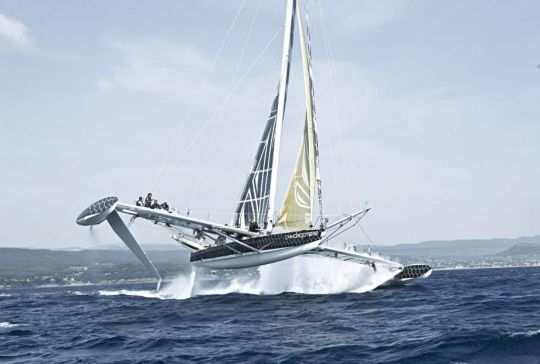
L'Hydroptère was the first yacht to pass the mythical 50 knot mark, and even peaked at over 100 km/hour (61 knots) before capsizing off Port-Saint-Louis-du-Rhone (December 21).
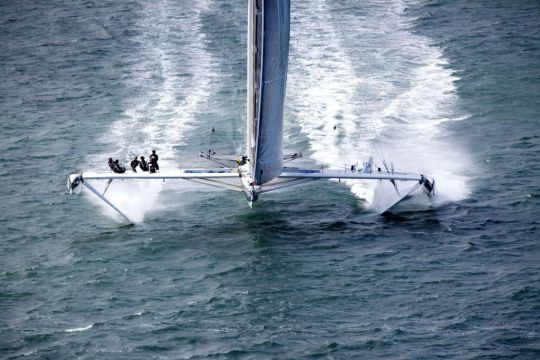
In Hyères harbour, l'Hydroptère once again beat the absolute speed record for sailing over 500 m with a sprint at 51.36 knots.
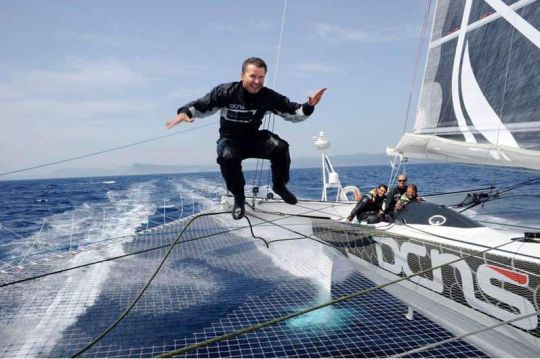
The hydrofoil, renamed DCNS after its new sponsor, is turning towards the open sea with the ambition of setting records in the open sea.
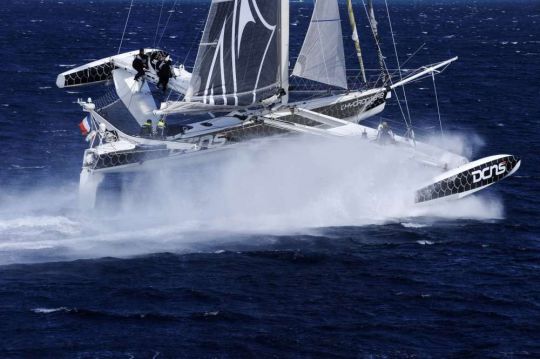
The trimaran is transported to California with a view to setting a record between the West Coast of America and Hawaii.
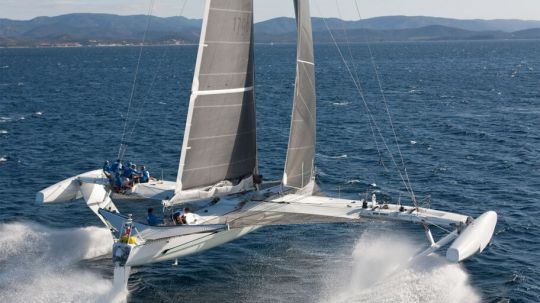
After a first aborted test in 2014, l'Hydroptère is once again taking on the Pacific. She will reach Hawaii after more than 11 days of sailing (the record to be beaten is 3 days...). Following this navigation, the boat was abandoned in a port on Honolulu.
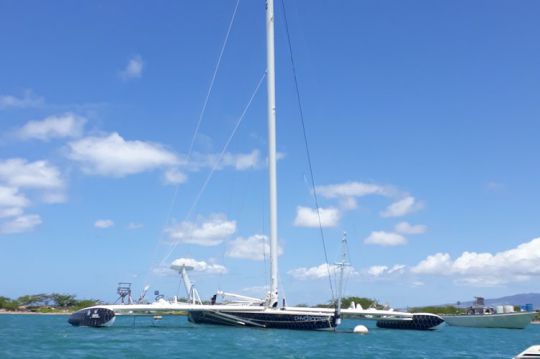
As recounted in our topic On June 28th, l'Hydroptère is bought at auction by Gabriel Terrasse (FRA) and Chris Welsh (USA) who want to sail her again as soon as possible.
Boat characteristics :
- Length: 18.24 m
- Wingspan: 24.50 m
- Mast height: 27.00 m
- Lengths of the side foils: 6.50 m
- Rudder height: 3.60 m
- Weight at sea : 7 tons ( 800 Kg of ballast in the wind)
- Mainsail : 165 m² (165 sqm)
- Mainsail 1 reef : 138.5 m² (138.5 sq. ft.)
- Mainsail 2 reefs : 110 m²
- Surface of the gennaker: 184 m²
- Surface of the Solent: 94 m²
- Surface of the trinquette: 49 m²

The epic story of Hydroptère in 8 minutes
The Hydroptere multihull hydrofoil design allows the sail-powered vessel to reach high speeds on water. The design is based on experience from a range of hydrofoil sailcraft that Alain Thébault built in cooperation with the late Éric Tabarly since the Hydroptere story. On October 5, 2008 she reached a record speed of 52.86 knots.
Hydroptere is a French experimental sailing hydrofoil trimaran imagined by the yachtman Éric Tabarly. Hydroptere project was managed by Alain Thébault, the design done by naval architects VPLP design and the manufacturing by a group of French high-tech companies. Its multihull hydrofoil design allows the sail-powered vessel to reach high speeds on water. The design is based on experience from a range of hydrofoil sailcraft that Thébault built in cooperation with Éric Tabarly since the 1980s. On 5 October 2008 she reached a record speed of 52.86 knots (97.90 km/h; 60.83 mph), however this was over a shorter distance than the 500m necessary to qualify for an official world record. On 21 December 2008, the Hydroptere briefly reached 56.3 knots (104.3 km/h; 64.8 mph) near Fos-sur-Mer, but capsized and turtled shortly thereafter.
On 4 September 2009, Hydroptere broke the outright world record, sustaining a speed of 52.86 knots (97.90 km/h; 60.83 mph) for 500 m (1,600 ft) in 30 knots (56 km/h; 35 mph) of wind. In November 2009, she broke the 50-knot (93 km/h; 58 mph) barrier for a nautical mile with a speed of 50.17 knots (92.91 km/h; 57.73 mph) in Hyères, France.
1936. Voyage around Cape Horn by schooner Wanderbird
Come sail away: 4 stories about sailing, sailing nandji ep 347 water damaged boat now ocean ready, plastiki expedition, the story of a fantastic sailing eco-adventure, live your passion, subscribe to our mailing list.
L'HYDROPTÈRE
Conceived by Éric Tabarly, developed by Alain Thébault and built by a consortium of major French industries, L'Hydroptère is a legendary foiling trimaran. 25 years ahead of its time, it pioneered high-speed foiling. She was the first sailboat to break the 50-knot barrier under sail, the equivalent of the sound barrier for aeronautics, and brought sailboats into a new dimension, that of the air.
L'HYDROPTÈRE'S TECHNICAL SPECS
Combining aeronautical and naval technologies, L'Hydroptère is built in carbon, Kevlar, titanium and aeronautical aluminum. Thanks to Alain Thébault and his team, as well as the various companies, schools and research laboratories that have supported the project and its development, she has never stopped evolving. With the notable contribution of the Ecole Polytechnique Fédérale de Lausanne (EPFL), she became, in 2009, the first sailing boat to break the 50-knot barrier, the equivalent of the sound barrier in aeronautics, and reached a top speed of 55.5 knots (102.8 km/h). Often dubbed "the Concorde of the seas", L'Hydroptère is an exceptional hydrofoil sailboat, the first to be built using modern composite materials, behind which lies a formidable human and technological epic. Entirely dedicated to innovation, L'Hydroptère is the ideal research and development platform for taking on board, testing and maturing your new technologies, and giving them worldwide visibility.
Copyright L'HYDROPTERE 2.0
For IEEE Members
Ieee spectrum, follow ieee spectrum, support ieee spectrum, enjoy more free content and benefits by creating an account, saving articles to read later requires an ieee spectrum account, the institute content is only available for members, downloading full pdf issues is exclusive for ieee members, downloading this e-book is exclusive for ieee members, access to spectrum 's digital edition is exclusive for ieee members, following topics is a feature exclusive for ieee members, adding your response to an article requires an ieee spectrum account, create an account to access more content and features on ieee spectrum , including the ability to save articles to read later, download spectrum collections, and participate in conversations with readers and editors. for more exclusive content and features, consider joining ieee ., join the world’s largest professional organization devoted to engineering and applied sciences and get access to all of spectrum’s articles, archives, pdf downloads, and other benefits. learn more →, join the world’s largest professional organization devoted to engineering and applied sciences and get access to this e-book plus all of ieee spectrum’s articles, archives, pdf downloads, and other benefits. learn more →, access thousands of articles — completely free, create an account and get exclusive content and features: save articles, download collections, and talk to tech insiders — all free for full access and benefits, join ieee as a paying member., fastest sailboat: alain thébault’s hydroptère, a french trimaran flies above the water.
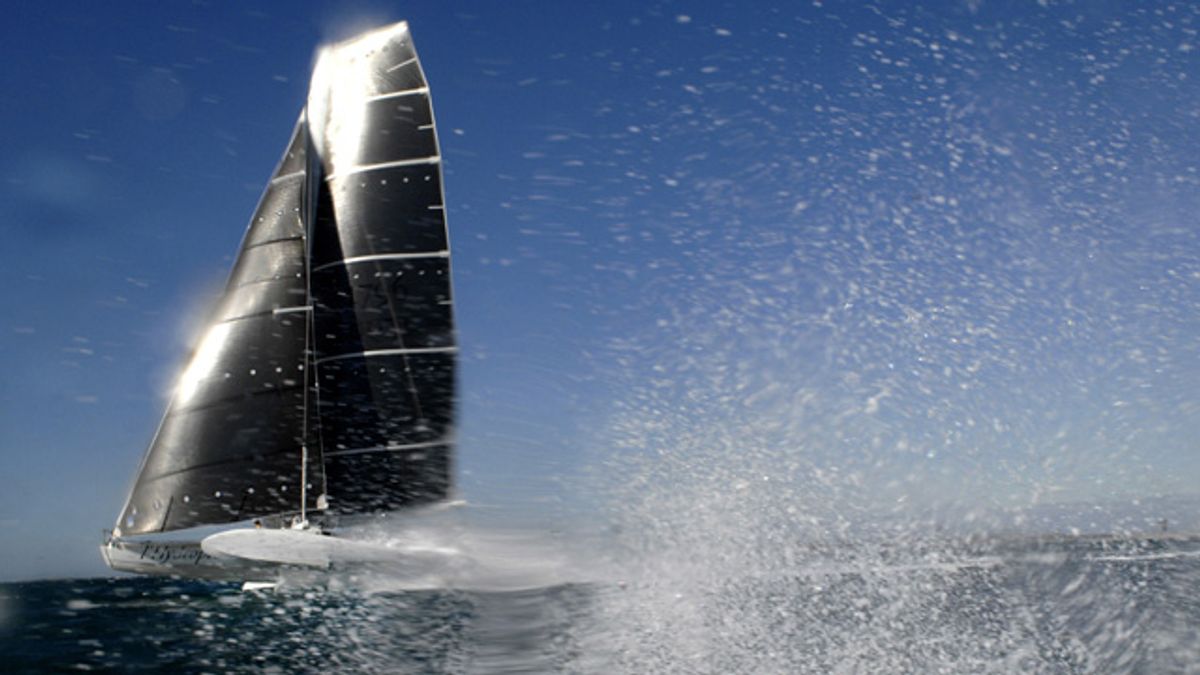
This segment is part of the IEEE Spectrum series “ Fastest on Earth .”
TRANSCRIPT:
Susan Hassler: What can you say about a 25-year-old boat that flies? That it’s fast. It’s French! And with an average speed of just above 50 knots—that’s 57.6 miles per hour—it holds the current world speed record for sailing. Giselle Weiss takes us aboard, in Lorient, France.
[cheering sounds, Hydroptère team celebrating in 2009]
Giselle Weiss: Named Hydroptère , the boat is the brainchild of Alain Thébault, a self-titled self-made man who grew up in an orphanage in Lorient, on the Brittany coast. Lorient is where Hydroptère is moored. One promising day in May, Thébault invites me to go for a sail. A dinghy ferries a small group of visitors out to the craft and we scramble aboard.
[splashing, voices]
Giselle Weiss: Hydroptère is a trimaran. Think catamaran with an extra longer hull in the middle. But Hydroptère has something more—a pair of winglike appendages, called “hydrofoils,” under the outrigger hulls. When the wind reaches 12 knots, equivalent to a light breeze, the foils produce enough lift to raise the 6-ton craft. Only the wingtips remain in the water.
[water sloshing]
Giselle Weiss: It was Thébault who piloted Hydroptère to victory in 2009. But today, copilot Jacques Vincent is at the steering wheel. Beside him, other crew members scan the water for clues and adjust the mainsail as the speed picks up, using cranks called “coffee grinders.”
[cranking noises]
Giselle Weiss: Hydroptère supports a maximum of 11 crew members. For races, that means nine on deck and two in the cabin watching the computers that collect data from stress sensors placed all over the boat.
Alain Thébault : Okay! Là, vous pouvez vous mettre en position de basse. On va bientôt décoller!
Giselle Weiss: Thébault tells the guests to duck down. The hulls have risen three meters above the water. The speedometer registers 23 knots. Thébault has compared early trials of Hydroptère on rough seas to being in a washing machine. But today, the ride feels great, as long as I sit still. Thébault himself bounds effortlessly across the trimaran’s trampoline deck like an astronaut on the moon. After about 10 minutes, the boat slows.
Alain Thébault : Donc, là, on va virer. Et on va chercher un peu d’air.
Giselle Weiss: The team fiddles with the sails to chase a little more wind. But the air has calmed. We cruise pleasantly back to harbor.
[quiet sailing sounds]
Giselle Weiss: Thébault began drawing sketches of the boat that would become Hydroptère in the early 1980s. In 1984, at the age of 22, he found his way to champion yachtsman Éric Tabarly and showed him his design. Impressed, Tabarly asked where Thébault was living.
Alain Thébault: I answered, “I’m living in my car!”
Giselle Weiss: Tabarly gave Thébault shelter, encouragement, and friendship. By 1985, Thébault had developed a scale model. The availability of carbon-fiber materials and the aid of the French aeronautical industry helped to advance the project. But hard work, and many failures, lay ahead.
Alain Thébault: When you want to break a record, first you break the boat. We crashed four times! It was a long process, and you need a stone spirit.
Giselle Weiss: A big challenge for Hydroptère is how to balance strength and lightness. In 2008, sailing off the coast of southern France, the boat briefly touched 61 knots—that’s 70 miles an hour—but flipped over and was towed back to shore.
Alain Thébault: The design of the shape of the hydrofoil was not good, and we lost the lift and suddenly we capsized.
Giselle Weiss: Hydroptère went into dry dock for redesign and rebuilding. A year later, the boat raced to victory in the Mediterranean, breaking two world records in the space of three months.
Alain Thébault: For us, it was really great.
Giselle Weiss: Thébault’s next big dream is to break the transatlantic record in 2014. For that, he will need a new boat, now being developed in France. The idea of winged boats goes way back. But none has yet matched Hydroptère . When Thébault was 10, he says, and longing for escape, he had two books: The Little Prince , by Antoine de Saint-Exupéry, and the Tales of Aladdin .
Alain Thébault: I was dreaming about a flying carpet. Now I’m lucky, because I fly it.
Giselle Weiss: I’m Giselle Weiss.
Music: “La Mer”
Qu’on voit danser le long des golfes clairs
A des reflets d’argent
Des reflets changeants
Sous la pluie….
Susan Hassler: On a program about the fastest things on earth, we’ll note that “La Mer” may be the fastest- written song ever. In 1943, the composer and singer Charles Trénet wrote it in 10 minutes, on toilet paper, en route by train from Paris to the French coast.
Music: “La Mer” continues.
Do We Dare Use Generative AI for Mental Health?
How to emp-proof a building, video friday: a starbucks with 100 robots, related stories, fastest swimmer: sailfish, fastest jet fighter: lockheed martin’s f-22 raptor, fastest helicopter: sikorsky aircraft’s x2.
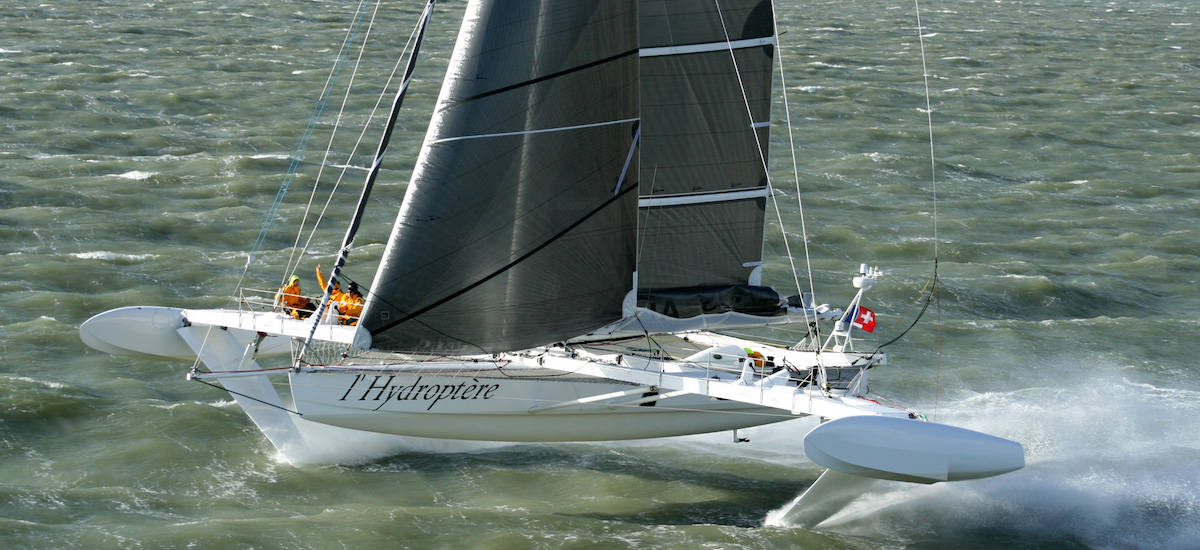
L’Hydroptère
The Hydroptère project was an extraordinary story spanning almost twenty-five years and one of VPLP’s oldest collaborations. Managed by Alain Thébault , working tirelessly in the wake of Eric Tabarly , the project was first discussed back in the 1980s. However it took until 1994 for the Hydroptère to be finally commissioned. Originally the idea was to build a foiling tall ship that could break ocean sailing records. Over time, however, the goal of the project shifted towards setting sailing-speed records .
This objective was achieved in September 2009 when she broke the symbolic 50-knot barrier , sustaining an average speed of 51.36 knots over a stretch of 500 metres… and briefly exceeding 55 knots. In 2013 Hydroptère returned to her initial vocation, setting the Los Angeles–Honolulu record. After resting for several years in Hawaii, she came to the attention of a Franco-American team which is currently preparing new projects for her.
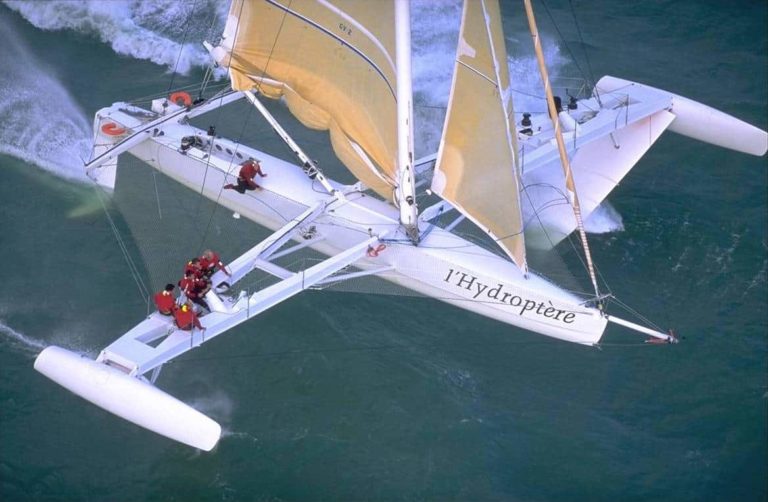
For VPLP the Hydroptère has been a fascinating project and an extraordinary testing ground for experimental research into how foils behave at very high speeds.
1994/1997/2001/2004/2006
proto 60' foiler
VPLP design
DCNS Airbus Décision (Suisse)
3.28 m/4.05 m
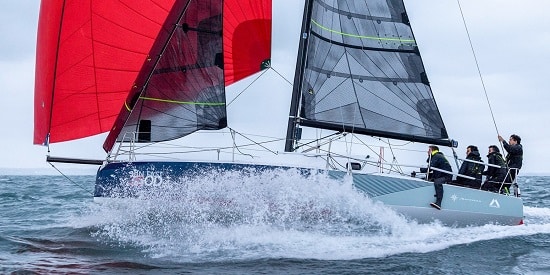
Sun Fast 30 One Design
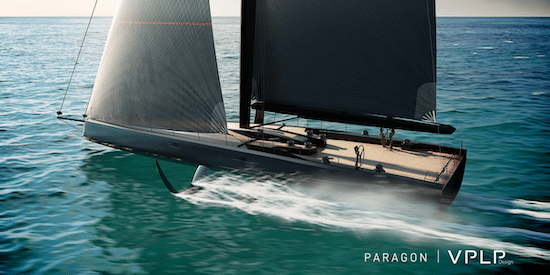
Paris +33 1 42 77 24 00 Vannes +33 2 97 44 74 19 Nantes +33 9 85 11 79 77
Privacy Policy
Subscribe to our newsletter
Switch language:

l’Hydroptère DCNS Hydrofoil Sailboat
l'Hydroptère is a hydrofoil-based experimental trimaran designed by Alain Thébault, a French yachtsman who is also the boat's captain. She officially became the world's fastest sailboat in November 2009, by breaking the outright nautical mile record. Approved by World Speed Record Council (WSRC), she recorded an average speed of 50.17kt over one nautical mile.
Hydrofoil-based trimaran
Construction Started
Maximum average speed, length overall.
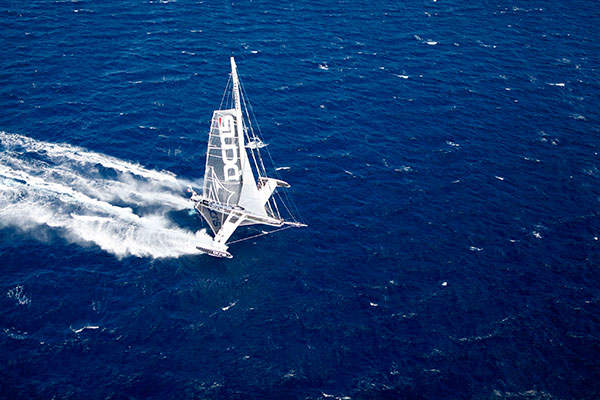
l’Hydroptère is a hydrofoil-based experimental trimaran designed by Alain Thébault, a French yachtsman who is also the boat’s captain. She officially became the world’s fastest sailboat in November 2009, by breaking the outright nautical mile record. Approved by World Speed Record Council (WSRC), she recorded an average speed of 50.17kt over one nautical mile.
Recommended White Papers
AIDAnova Put to the Test
Sustainable water solutions for the marine industry, recommended buyers guides.
Marine corrosion inhibitors: Control, prevention and protection
Sustainable shipping companies and solutions.
The boat’s name ‘l’Hydroptère’ was derived from two Greek words: hydro and pteron, which mean water and wing respectively. In January 2012, DCNS, a French naval defence company and one of Europe’s leading shipbuilders, became the ship’s sponsor and consequently her name was changed to l’Hydroptère DCNS.
In August 2012, the sailboat arrived in San Francisco Bay to participate in America’s Cup World Series race.
History of l’Hydroptère
The conceptualisation of l’Hydroptère dates back to 1975 when late Éric Tabarly (July 1931 – June 1998), a famous French yachtsman and an officer in the French navy, was told about viability of such a project.
In 1983, Alain Thébault took over the project. With Éric Tabarly’s guidance, he was able to build a model of the boat in 1985 and sailed it on the Grand Canal at the Château of Versailles, France. In 1992, Alain was able to get support from DCNS, Aérospatiale, Dassault and the Chantiers de l’Atlantique shipyard. They all decided to become a part of the project.
Construction of the boat commenced in 1993, with DCNS manufacturing the hull. It was completed in 1994 and in her maiden flight, l’Hydroptère was able to achieve a speed of 28kt.
The ship was taken out of action in 1998 after one of her hydrofoils was torn away. The incident occurred when she was trying to break the speed record for 24 hours. She returned to the water two years later after being fitted with a new hydrofoil. She was also armed with a 3D flight simulator.
Design of the experimental trimaran
The l’Hydroptère DCNS project was made possible by combining aeronautical and marine techniques. The three-hulled trimaran can fly five meters above the surface of water. In flight mode, the boat’s contact area with water is reduced to 2.5m 2 .
The boat’s take off is attained by her hydrofoils, which are fitted underneath each of the outrigger hulls. These are angled at 45° in water and give an upward thrust as soon as the boat reaches 10kt speed. The thrust that makes the ship to rise above the surface of water is produced due the difference in pressure between the upper and lower surfaces of the foil. The lift increases with the increase in speed. The ship can reach a speed of 45kt from 20kt in ten seconds.
The ship’s hydrofoils or wings are made of titanium coated carbon fibre to make them stand against powerful stresses. The boat’s optimised shape, which was attained by applying aerodynamic principles, ensures that she gets maximum efficiency from her sails and at the same time keeps the wind-resistance to a minimum.
l’Hydroptère DCNS specifications and speed
Related project, .adastra superyacht, zhuhai, china.
Adastra is a trimaran-type superyacht built by McConaghy Boats for Hong Kong-based shipping baron Anto Marden. The 42.5m (140ft) superyacht has been designed by UK-based John Shuttleworth Yacht Designs.
The overall length of the boat is 22.48m. The beam is 24m and draft (while in water) is 3.5m. The ship’s draft is reduced to 2m while flying. The length of outrigger hulls is 6.7m, while the length of each hydrofoil is 5.7m. The boat’s weight is 7.5t.
The mast is 28m tall. Gennaker area and mainsail area of the sails are respectively 315m 2 and 185m 2 in size.
The trimaran requires about 12kt of stabilised speed to take off. Her speed is approximately two times that of wind; in other words the boat cruises at 30kt with 15kt of established speed. Maximum speed of the boat is 56kt and maximum average speed on one nautical mile is 50.17kt.
Contractors and suppliers involved in the hydrofoil trimaran project
Van Peteghem Lauriot-Prévost (VPLP), a French naval architectural company, and HDS were the main architects of l’Hydroptère DCNS.
The central hull of the boat was manufactured by DCNS Lorient, while floats and crossbeams were built by shipyards Decision and Airbus Nantes respectively. Foils and rudder were built by B & B and Airbus Nantes, and mast by Lorimat. Strain absorbers were provided by Legrand & Revigny.
Related Projects
More Projects

Radio controlled shunter supporting ports in Finland
Spanish port grapples with allegations of ships carrying arms to israel, rhine port of kehl launches feasibility study for wind energy, india and iran strengthen chabahar port partnership with new deal, sign up for our daily news round-up.
Give your business an edge with our leading industry insights.
Sign up to the newsletter
Your corporate email address.
Ship Technology In Brief
Ship Technology Global
I consent to Verdict Media Limited collecting my details provided via this form in accordance with Privacy Policy
Thank you for subscribing
View all newsletters from across the GlobalData Media network.
Yachting World
- Digital Edition

L’Hydroptere hits 61 knots
- Matthew Sheahan
- December 21, 2008
…and then capsizes. Matthew Sheahan reports
Things had gone well for the L’Hydroptere team over the last few weeks. The consistent northerly breeze off Napoléon beach at Port-Saint-Louis-du-Rhône just to the west of Marseille has provided near perfect conditions for the French speed record team to gradually press harder on the gas and see the top speed of this extraordinary 60foot foiling trimaran increase day by day. With speeds regularly in the early 50s the team was confident of breaking the outright world speed record measured over 500m. They already have the record for the world’s fastest speed over 1 nautical mile.
But, having waited two days for the weather to moderate over the weekend, the team’s plans to break the ultimate world sailing speed record came to an abrupt halt as L’Hydroptere capsized during a squall. Just moments before she had reached an incredible peak speed of 61 knots!
Here’s how the team published the news on Sunday afternoon, shortly after the capsize.
A milestone in the history of l’Hydrotpère!
l’Hydroptère has just recorded a speed peak of 61 knots this morning. Thus, the flying trimaran is the first sailing boat to reach such an extraordinary speed.
Wind conditions were pretty tough with an established wind at 35-38 knots and gusts at over 45 knots off Napoléon beach at Port-Saint-Louis-du-Rhône, which is the speed base of l’Hydroptère, certified by the WSSRC.
In these conditions, the trimaran started the first full speed run of the day. Taking advantage of the established wind, the speed progressively increased: 50, 55 and then 61 knots at top speed!
The squall that provoked this acceleration was really powerful and resulted in l’Hydroptère’s capsizing.
For the moment, Alain Thébault and his crew are preparing the towage of the trimaran, which will be moored in Fos sur Mer before being put in dry dock.
The crew members are suffering from little injuries but they are above all delighted with this speed peak which confirms the boat’s potential. They are impatient to get back to the attempts and stabilize those impressive speeds.
Last week I sailed aboard L’Hydroptere for two days, during which time we clocked 42.85 knots. You can listen to the run and an interview with skipper Alain Thebault on our podcast.
Shoretalk Flies Aboard L’Hydroptere.

Published on July 3rd, 2015 | by Editor
Slow trip for Hydroptere to Hawaii
Published on July 3rd, 2015 by Editor -->
Honolulu, HI (July 3, 2015) – The 60-foot foiling trimaran Hydroptere left Los Angeles on Monday June 22 and has just arrived in Honolulu after a crossing of more than 2215 nautical miles (4102 km). Hydroptere becomes the first flying hydrofoil to make such a significant ocean passage.
The transpacific speed record from Los Angeles to Honolulu, Hawaii was not beaten as the weak wind conditions along the route did not allow the trimaran to achieve high cruising speeds. The outright record is 04:19:31:37, set by skipper Olivier de Kersauson (FRA) and crew on the 110-foot trimaran Geronimo in November 2005. The Hydroptere passage took nearly 11 days.
The challenge of this first crossing was of a different nature. Despite clearly unfavorable conditions, Alain Thébault and his crew took the decision to go not to miss a historic encounter. Within a few hours, André Borschberg aboard Solar Impulse, the first 100% solar energy powered aircraft, in turn, will land in Hawaii. An exceptional encounter will take place between two legendary vessels, one powered by the energy from the sun and the other one by that of the wind. Two hightech monsters, two pioneers in their field and a single message: “use clean energy. »
For over 25 years, Alain Thébault has been pursuing his childhood dream: to make sailboats fly. From the first wooden models in the early eighties, to absolute sailing speed records in 2009, Hydroptere became the ambassador of sailboats with hydrofoil technology.

In 2009, the French trimaran became the fastest sailboat in the world with peaks at over 100 km/h on a flat sea. Today it is aboard the same sailboat that Alain Thébault, Jacques Vincent and four American crew members, Don, Joe, Jay and Will just crossed 2,215 nautical miles (4,102 km) in pure ocean conditions.
This ocean crossing is notable as hydrofoil sailboats to date have been confined to high performance on flat water.
“This is a historic moment,” remarked Thébault. “I promised André and Bertrand to be in Hawaii to greet them upon arrival. We knew the wind was going to be weak. The crossing should have been much shorter but from the second day, we were forced to make a major detour far to the south to avoid an impressive debris plate. Without this decision, we would have broken the boat.
“We still made peaks at over 35 knots the first days. It is obviously frustrating but we had to make the choice of reason. We will get back on stand-by in Long Beach as soon as possible. With favorable winds, the current record is within the reach of Hydroptere. However, in any adventure, you need a bit of luck. I am very happy because this year, the Pacific has kindly let us through.”
Team website – Tracking
Note : The transpacific speed record from Los Angeles to Honolulu, Hawaii is separate from the 2,225nm Transpac Race record which is 5d 9h 18m 26s, set during the 1997 event by the 86′ maxi cat Explorer.

Tags: Hydroptère , records
Related Posts
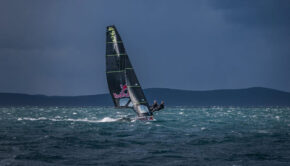
VIDEO: Going where you shouldn’t go →

Record setting day on a monohull →
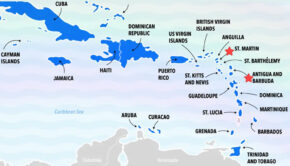
Curb the enthusiasm for records →
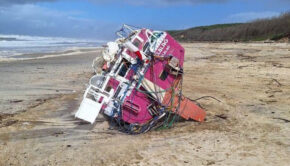
Storms spoil solo circumnavigation →
© 2024 Scuttlebutt Sailing News. Inbox Communications, Inc. All Rights Reserved. made by VSSL Agency .
- Privacy Statement
- Advertise With Us
Get Your Sailing News Fix!
Your download by email.
- Your Name...
- Your Email... *
- Name This field is for validation purposes and should be left unchanged.

- svg]:stroke-accent-900">
Concepts & Prototypes: A Flying Boat
By Dawn Stover
Posted on Jul 11, 2010 8:53 PM EDT
3 minute read
Length: 100 feet Mast height: 130 feet Span: 90 feet Weight: 20 tons Crew size: 10 Top Speed: 50 knots Daniel Schumpert
The team behind the world’s fastest sailboat—l’Hydroptère, a 78-foot trimaran that sailed at a record-breaking 50-plus knots (nearly 58 mph) for more than a nautical mile last year—is designing a new model to break another big racing record. With l’Hydroptère Maxi, a crew 0f 10 hopes to sail around the world in less than 48 days and eight hours, beating the current fastest time as set by the French crew of Groupama last March.
The Maxi’s skipper, Alain Thébault, who has been creating high-speed sailboats for 25 years, has assembled a team that includes advisers from the Swiss Federal Institute of Technology and aeronautical engineers. Like l’Hydroptère, whose name comes from the Greek words for water and wing, l’Hydroptère Maxi will be part boat and part plane. At slower speeds, it will glide through the water like a conventional trimaran, floating on a center hull flanked by two stabilizing hulls. But at faster speeds, submerged finlike hydrofoils attached to the bottom of the side hulls act like airplane wings, forcing water over the curved top surface of the foils to lift the hull up to 33 feet above the water. With no drag acting on the hulls, the boat essentially flies across the ocean.
Breaking the record, not to mention keeping the crew safe, rests on the perfect design of the foils and hulls. If the wings snap in rough weather or the hulls suddenly smack into the water, the boat could take a nosedive. “Flying in waves can be dangerous,” says lead designer Jean-Mathieu Bourgeon. Another big challenge is making the boat as light as possible without sacrificing too much strength, to maximize speed and safety in both floating and flying modes.
Thébault and his group will spend the next year designing l’Hydroptère Maxi, including testing scale models of the foils in computer simulators. If all goes as planned, the crew could set sail as early as 2013, possibly starting in Europe and heading south through the Atlantic Ocean to circle Antarctica.
Centerboard
When the wind speed is low—less than 15 knots—the crew deploys a centerboard [not shown] and raises the foils out of the water, switching the boat from flying to floating mode.
Crew Controls
Using real-time measurements from stress sensors, GPS and an inertial unit, which measures factors such as roll, pitch and speed, the crew can adjust the boat accordingly for the most efficient sailing.
Crossbeams made from lightweight carbon and titanium connect the central hull to two side hulls. Blueprints for hydrofoil trimarans date back to the 1950s, but not until the advent of composite materials could engineers build strong enough crossbeams to support boats as large as the Maxi.
Unlike the foils on most multihull racing boats, which reduce drag but do not raise the boat completely out of the water, Maxi’s underwater wings lift it up to 33 feet above the ocean’s surface.
Maxi has two rear tail units for better balance when elevated on its foils.
Video Imaging
The team will use video cameras to film sail behavior, crossbeam deformation, and how far the foils are immersed in water under various conditions. Computer models are then refined to predict how the boat will behave under even more extreme conditions.
Stress Testing
Researchers will outfit a prototype of l’Hydroptère Maxi with strain gauges, accelerometers, and pressure and rotation sensors. Computer simulations will use the data to help designers understand the behavior of the boat as a whole and push the design to its physical limits. This example shows stress distribution [red indicates areas that deform most under pressure].
Latest in Aviation
See the b-21 nuclear stealth bomber’s first official flight photos see the b-21 nuclear stealth bomber’s first official flight photos.
By Andrew Paul
Tracking private jets just got much harder Tracking private jets just got much harder
- 0 No item in your cart
- SUBSCRIPTION
- Classified Ads
- Technical Specifications
- Destinations
- Address book

- All the magazines
The Hydroptère in ocean-going mode

Article published on 26/03/2013
By Jean-Christophe Guillaumin
published in n°Previous issues jan. / feb.

Create a notification for "Catamaran"
We will keep you posted on new articles on this subject.
Did you like this article ?
Share this article
Most-read articles in the same category.

MYBA 2024 - In Genoa for its 40th anniversary

EMMYS 2024 - Multihulls everywhere in Poros, Greece!
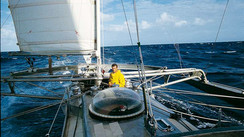
Pen-Duick IV - A replica to take on the 2026 Route du Rhum - Destination Guadeloupe!
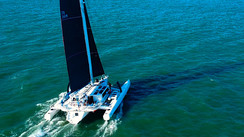
Rapido 53XS - A peak speed of 24 knots during initial seatrials!
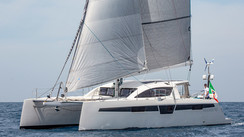
C-Cat Catamarans - A week of private seatrials
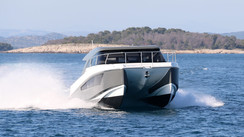
Makai M37 - World premiere in Palma
What readers think.
Post a comment
No comments to show.
Follow us on
Vous avez ajouté " " à vos favoris., vous avez supprimé " " de vos favoris., in order to add this article to your favorites, please sign in..
- AROUND THE SAILING WORLD
- BOAT OF THE YEAR
- Email Newsletters
- America’s Cup
- St. Petersburg
- Caribbean Championship
- Boating Safety

The Race to Break the Speed Record
- By Kimball Livingston
- Updated: October 26, 2021
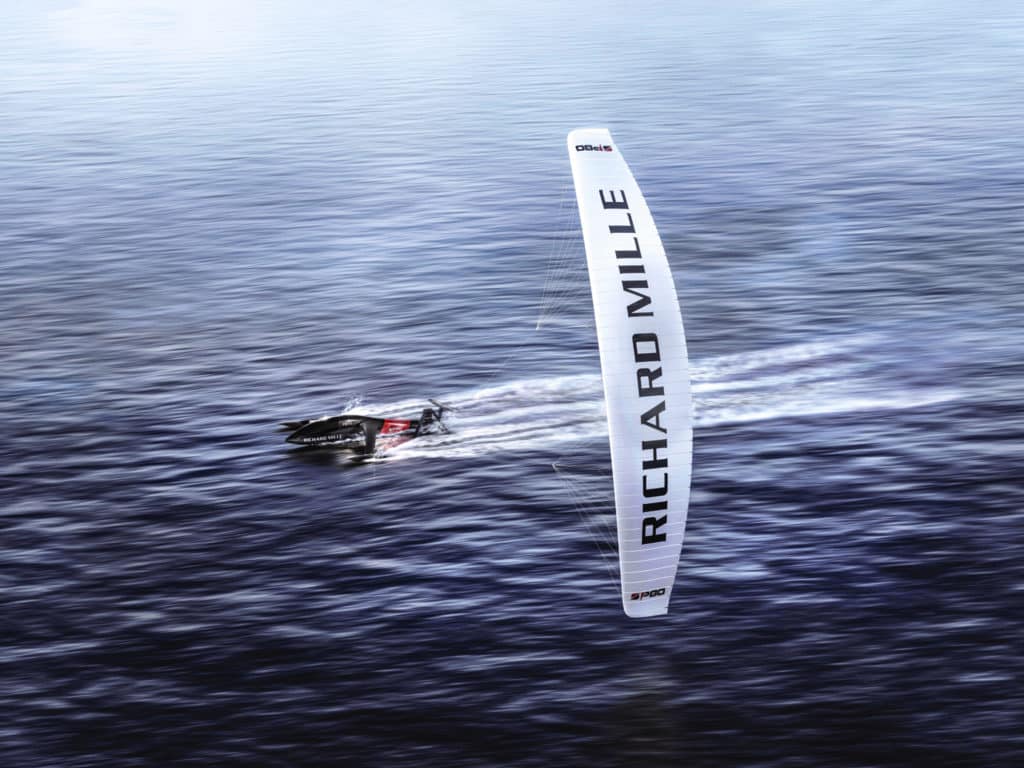
If Alex Caizergues succeeds at breaking the speed sailing world record in 2022, it will be his third time around using a kite, but otherwise completely different from his first two records. Those marks—50.57 knots in 2008 and 54.10 in 2010—were set when foiling boards were continually upping the 500-meter mark, sometimes more than once a year. Caizergues’ 2010 run added 3 knots to what the famed trimaran L’Hydroptere had shown us only a year before. But all those efforts ran into cavitation trouble at about 52 knots, that point when flow over the foils boils into vapor—the point at which control vanishes. For his early records, Caizergues used a hydrofoil to lift him above the water. Now, with his Syroco team based in Marseille, France, he intends to use a hydrofoil to hold him down.
We’ll come back to that.
Nine years after Paul Larsen’s record run at 65.45 knots in Sailrocket , the French Syroco team has rivals in Switzerland following what they believe is a more conservative path. The École Polytechnique Fédérale de Lausanne is a public research facility where the speed quest caught fire with student engineers and professors, including some who helped develop L’Hydroptere back in the day. SP80 is the team name, taken from the goal of achieving 80 knots, a goal shared with Syroco. They have a kissing-cousin relationship, competition aside.
SP80 envisions hitting 80 knots with a kite pulling a surface-skimming trimaran. A subsurface superventilating foil counters the lift of the kite, and a mechanical interface aligns the forces. Syroco’s purified vision aims to put a kite in the air connected by wires to a pod also in the air carrying two “pilots.” That pod will have a single, tiny-as-possible connection to a supercavitating subsurface foil holding it down. The concept strips the speed problem to its barest fundamentals, exponentially raising the complexity of execution.
Neither concept would pass as a boat in Blue Blazerville. Both owe their origins to Bernard Smith’s book, The 40-Knot Sailboat , published in 1963 . Smith proposed a balance of opposing forces to avoid the ultimate instability that eventually and inevitably develops as power is added, and any ordinary craft will capsize. Sailrocket showed the way and validated the theory—using a canted wing, countered by a superventilating foil in the water. On November 24, 2012, with sponsorship money down to nickels and the weather window closing, Larsen clocked his 65.45-knot run at Walvis Bay, Namibia. These days, Larsen says he appreciates the respect shown by the principals of SP80 and Syroco when they call themselves “children of Sailrocket .” But when we keep this Australian-born Briton talking, we get to the part where he’s saying how the machine was packed away in a container in Namibia after just a few days of finally showing its potential, and there’s still gas in the tank and…
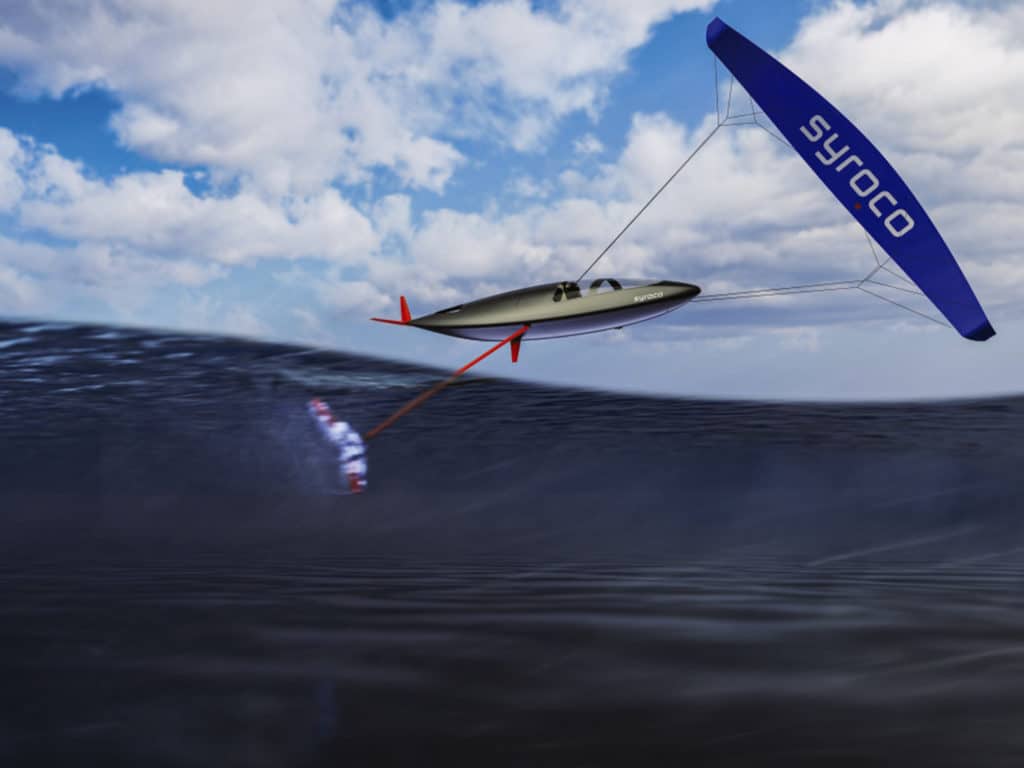
There’s nothing shaking right now, but don’t dismiss the current record holder, 49 years after the catamaran Crossbow set the first official 500-meter record at 26.30 knots. For bonus points, do you know how 500 meters became a standard record distance?
The simple answer: In 1972, when Crossbow was first contending at Weymouth, UK, that length fit the venue. If someone manages 80 knots in 2022, they will cover 500 meters in 12.15 seconds, a football field every 2.5 seconds.
Later, while we’re talking records, we’ll update the renovation of L’Hydroptere . First, let’s get up to speed on the essential terms. Supercavitation refers to a regime in which a small, highly loaded, wedge-shaped (triangular profile) foil builds a stable vapor pocket that bypasses the limits of cavitation. Superventilation refers to the principle employed by Sailrocket , with a foil that encouraged ambient air pressure to travel down the entire length and span of the foil.
The SP80 team puts it this way: “A triangular profile allows air from the atmosphere to dive into the extrados side caught by the depression, forming a stable air bubble that will prevent cavitation inception.”
Got it? Hey, they’re engineers.
Caizergues is aiming for more than a speed record with his Syroco concept. He knows from experience that when you succeed, you’re done and, “It’s an empty feeling.” This time, he’s ambitiously building a scientific and technical company around Syroco with the aim of reducing carbon emissions in the transportation and energy sectors. Co-founder Olivier Taillard, a Mini-Transat veteran, relates: “We founded the company in 2019 and built a team of 20. That includes three Ph.D.s in physics. To date, we have created 12 innovations, with three in the market. One is a software tool now in use to maximize efficiency in shipping routes.”
Other developments are aimed at keeping that critical hydrofoil just barely under the surface of the water, doing its supercavitating thing. Under the rules of the World Sailing Speed Record Council, only mechanical systems are allowed. It can’t be computerized or fly-by-wire. To a pointed question about systems, Caizergues responds with a laugh and a cagey hint: “Because of the wire, we’ll have air coming down from the surface, so it’s going to be about managing ventilation along with employing the principles of supercavitation. Not a lot of work has been done in this area, so we’re leading the way.” Prototype testing began in summer 2021, with plans to go for the record in 2022. Alongside more sober developments aimed directly at the marketplace, the team calls this one “the moonshot.”
When these people talk to each other, they toss around stuff like “turbulent viscosity formula in the Standard K-Epsilon model.” It’s not “let it out till it luffs, then pull it in.” SP80 co-founder Mayeul van den Broek observes: “Like Sailrocket , both of the current record efforts are based on the concept of aligning opposed forces, but then you prioritize either efficiency, power or stability. Syroco chose efficiency as a top priority. We chose stability, which is why we are producing such a different realization of the same concept.”
The SP80 principals witnessed L’Hydroptere ’s stunning record run in 2009 and never quite got over it. Then, during a university competition to design the most efficient radio-controlled boat, they developed a hankering to try a superventilating foil on a kiteboard. When Benoit Gaudiot easily hit 41 knots, van den Broek says: “We saw that the rider was the weak link, and if we wanted to go faster, we would need a rigid link between the kite and the foil. Then, well, we might as well go for the record. We will use inflatable kites, even though a wing might be more efficient, because new-generation kites will serve at 80 knots. We can be versatile, launching kites from 20 to 50 square meters for different conditions.”
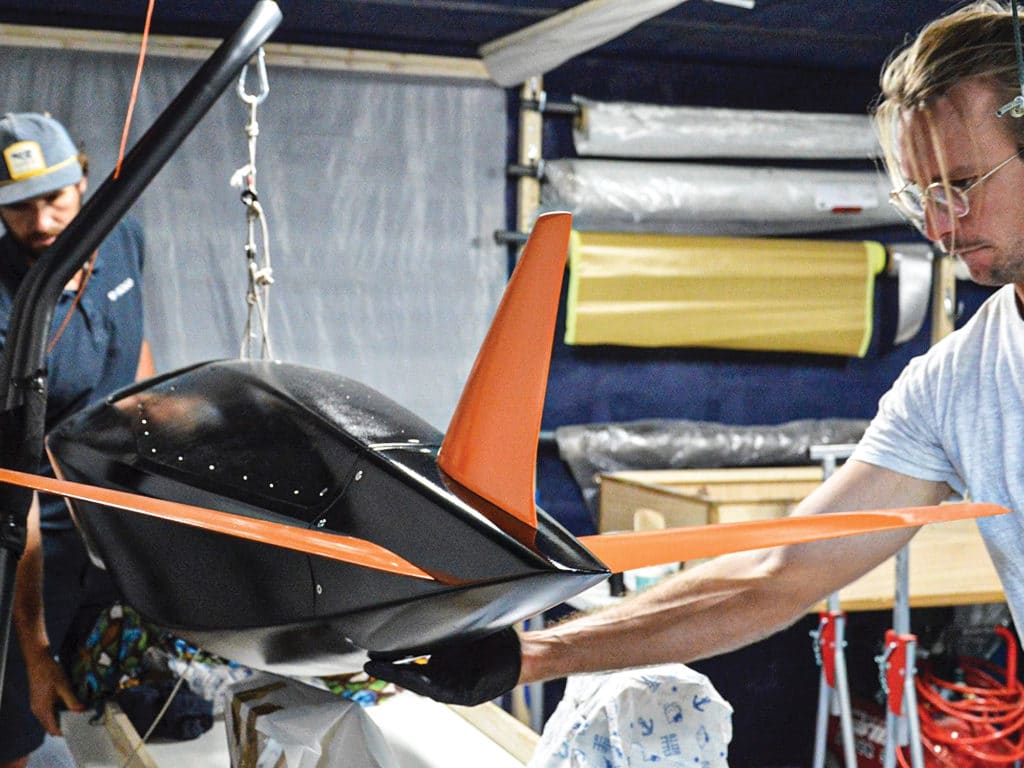
Their superventilating foils, Gaudiot says, “will have water flowing on one side and air on the other. Sailrocket used similar superventilating foils. That is less efficient than a supercavitating foil generating vapor, but it’s a lot more stable. A superventilating foil at low speed will develop more drag than a conventional foil. At high speed, it has no limits.”
SP80′s link between airfoil and hydrofoil depends upon a module that is, “mechanical but automatic,” according to van den Broek. “It will be close to the controls of a conventional kite.” Gaudiot adds, “Having one line carry all the power allows you to know exactly where that power will be coming from, and you can advance it into the window ahead for best performance, like any kite.”
In theory, there is no heeling and no capsizing because the power of the kite is countered by the force of the foil. As with Syroco, 2022 is the target record date.
Last year, we wrote in these pages about an ambitious plan to rehab the 60-foot foiling trimaran L’Hydroptere and put the old girl to work as a point-to-point record hunter. Gabriel Terrasse and Chris Welsh partnered to buy the legendary campaigner, once left derelict in Hawaii. They patched it up and had it sailed to San Francisco, where it was taken apart with an intent to rebuild it better than ever. Work was well along when Welsh—who would have carried on with or without sponsorship—died suddenly, and all bets were off, save for Terrasse’s persistence.
“We’re looking for sponsors,” Terrasse says, “and we have engineers studying how to add ground effect to L’Hydroptere 2.0 along with new foils, a longer and lighter main hull, a wingsail, global aerodynamic optimization and much more. It was hard to lose Chris. We shared the dream. But L’Hydroptere has great potential to serve science and catalyze innovation.”
L’Hydroptere ’s 51.36-knot run in 2009 represented a last shot at setting speed records on water through pure muscle. Paul Larsen’s nine-year quest to solve the problem at a technical level culminated in that 65.45-knot run in 2012. Today the beast is still in a dark container in Namibia where Larsen packed it away. And yes, considering that Sailrocket had only a handful of runs in what turned out to be record-setting mode—fat foils, not thin foils, and according to the team’s VPP, 65 knots was a worst-case outcome; everything was structured to go 80 knots—it’s tempting to imagine putting Sailrocket 2 back on the track. What would change is the safety regime. It’s not hard to find videos online of early-version Sailrocket 1 going aerial.
“In any future scenario, I’d want a roll cage and oxygen,” Larsen says, “and maybe I’m at a point where I’d be happy to see someone else sitting there.”
“Tell Paul he’s getting soft,” was the joking comeback from Richard Jenkins when I mentioned that to him. Jenkins holds the land-speed sailing record at 126.2 knots, which took him “only” 10 years of trying as his various iterations developed. As far as we know, no one is challenging that record today. Jenkins’ story speaks to the difficulty of these endeavors in any medium. He says: “I’m often asked if I would try to break the record again. If I had unlimited funding and built a new vehicle, based on my cumulative knowledge, it might take me five years or more, and then we’d probably see an increment of 1 or 2 percent. It takes being in the right place at the right time, with certified observers, which is hard to put together. You then have to be technically perfect, at the right moment, with virtually no testing because wind might come suddenly. It takes a great deal of time and experience—and then you shoot from the hip. I have better things to do.”
Running his company, Saildrone, for example, with which Jenkins does his own part to care for the planet by fielding autonomous surface vehicles for ocean research. Having built a kite-powered trimaran 20 years ago, Jenkins worries the Swiss are “barking up the wrong tree.” But technologies evolve, and 2022 bids to be a fascinating time. Of Syroco’s moonshot, Taillard says: “Half of our brain power is spent making it safe. If a foil breaks, or if it comes out of the water—which isn’t going to happen—all safety systems have to work perfectly.”
Caizergues, who will be in Syroco’s control pod with a co-pilot, adds: “One of the goals is to produce a craft that will be safe for me to drive. And to crash. Helmets, oxygen, padding, quick-release mechanisms for sure, and we’re not committed to air bags, but maybe.”
Syroco and SP80 intend to run in the south of France, where the Mistral roars down to the Med. It worked for L’Hydroptere , but these new efforts place ever more extreme demands upon managing the interface between air and water, which at sea level is 784 times the density of air. The world will be watching, and perhaps I speak for many when I say, “Gentlemen: May the alignments of force be with you.”
- More: print fall 2021 , Racing
- More Racing
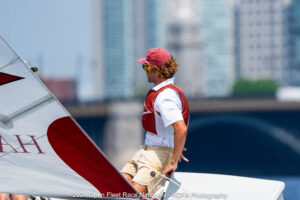
Harvard Wins Dramatic College Sailing Open Fleet Championship
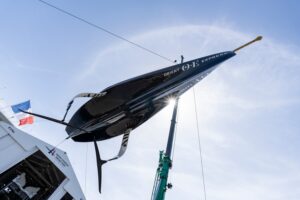
Orient Express Racing Team Joins AC75 Fleet
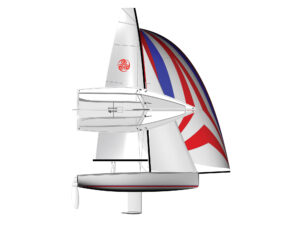
The Storm 18 is Brewing
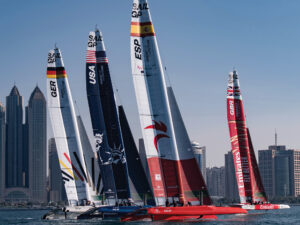
The Rebirth of SailGP’s US Squad
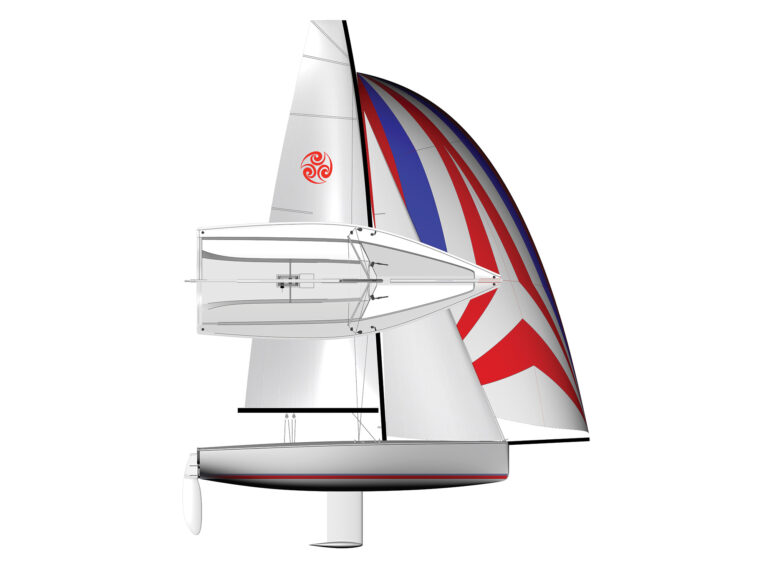
Local Knowledge For Detroit
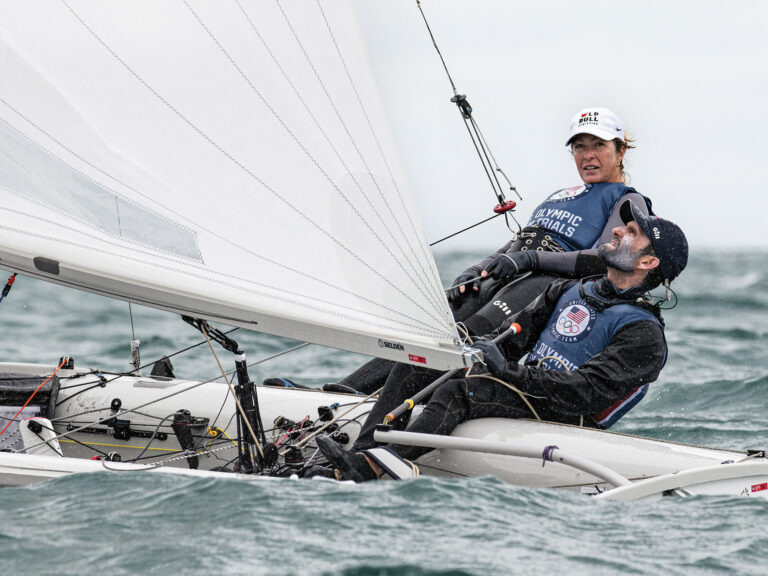
From Trials to Games

- Digital Edition
- Customer Service
- Privacy Policy
- Cruising World
- Sailing World
- Salt Water Sportsman
- Sport Fishing
- Wakeboarding

IMAGES
VIDEO
COMMENTS
Hydroptère is a French experimental sailing hydrofoil trimaran imagined by the yachtman Éric Tabarly.The Hydroptère project was managed by Alain Thébault, the design done by naval architects VPLP design and the manufacturing by a group of French high-tech companies. Its multihull hydrofoil design allows the sail-powered vessel to reach high speeds on water.
The Return of l'Hydroptere. Over the course of her long and eventful life, the 60-foot foiling trimaran has endured dramatic highs and lows. Now, under the command of a fresh group of fanatic sailors, she's gearing up to soar once more. Some 50 years after she was originally conceived, the rangy 60-foot trimaran l'Hydroptère's long ...
The foiling trimaran Hydroptere DCNS off San Francisco in 2012 with Alain Thabault and crew Jacques Vincent, Yves Parlier, Jean Le Cam and Robert Douglas. Photos: Christophe Launay/DPPI.
L Hydroptere blasts all sailing records out of existence with a 51 knot average speed over 500m in 28 knots of breeze. More on http://www.adriaan.com
In September 2009, L'Hydroptère broke the mythical 50-knot barrier - the equivalent of breaking the sound barrier in aeronautics. Two months later, on November 8th, L'Hydroptère confirmed its status as the world's fastest flying trimaran, with 51.36 knots over 500 m, 50.17 knots over 1 nautical mile and a top speed of 55.5 knots (102.8 km/h).
L'Hydroptère is a trimaran flying on 2 huge foils installed under the floats and a lifting plane on the rudder. Entirely built in carbon sandwich, this sailboat weighs about 7 tons. It uses landing gear shock absorbers from the Rafale aircraft to absorb the forces on the foils. Measuring 18.24 m long (60 feet), it is its width which is impressive with 24.50 m between the 2 small floats.
On October 5, 2008 she reached a record speed of 52.86 knots. Hydroptere is a French experimental sailing hydrofoil trimaran imagined by the yachtman Éric Tabarly. Hydroptere project was managed by Alain Thébault, the design done by naval architects VPLP design and the manufacturing by a group of French high-tech companies. Its multihull ...
Conceived by Éric Tabarly, developed by Alain Thébault and built by a consortium of major French industries, L'Hydroptère is a legendary foiling trimaran. 25 years ahead of its time, it pioneered high-speed foiling. She was the first sailboat to break the 50-knot barrier under sail, the equivalent of the sound barrier for aeronautics, and ...
Giselle Weiss:Hydroptère is a trimaran. Think catamaran with an extra longer hull in the middle. But Hydroptère has something more—a pair of winglike appendages, called "hydrofoils," under ...
Hydroptère is a French experimental sailing hydrofoil trimaran imagined by the yachtman Éric Tabarly. The Hydroptère project was managed by Alain Thébault, the design done by naval architects VPLP design and the manufacturing by a group of French high-tech companies. Its multihull hydrofoil design allows the sail-powered vessel to reach high speeds on water.
Not long, aboard the foiling trimaran, l'Hydroptère DCNS. The big, French "water wing" holds the nautical-mile record at 50.17 knots and now has its sights set on a Los Angeles-Honolulu record. On my day aboard in Southern California, we topped out at 38 knots. While I was driving, we saw 34 knots. Later, when we slowed to 22, I thought ...
L'Hydroptère. The Hydroptère project was an extraordinary story spanning almost twenty-five years and one of VPLP's oldest collaborations. Managed by Alain Thébault, working tirelessly in the wake of Eric Tabarly, the project was first discussed back in the 1980s. However it took until 1994 for the Hydroptère to be finally commissioned.
"l'Hydroptère is a hydrofoil-based experimental trimaran designed by Alain Thébault, a French yachtsman who is also the boat's captain." The conceptualisation of l'Hydroptère dates back to 1975 when late Éric Tabarly (July 1931 - June 1998), a famous French yachtsman and an officer in the French navy, was told about viability of ...
French trimaran l'Hydroptère sets the bar pretty high when it comes to flying boats. Come summer 2013, her crew aims to break the Transpacific record, sailing from Los Angeles to Honolulu. Starting at the end of May, Skipper Alain Thébault, who also designed the boat, Jean Le Cam, Yves Parlier and Jacques Vincent will be on standby for the ideal weather to start the journey.
l'Hydroptère has just recorded a speed peak of 61 knots this morning. Thus, the flying trimaran is the first sailing boat to reach such an extraordinary speed.
http://yachtpals.com/hydroptere-4036 Hydroptere, the fastest sailboat in the world!!! L'Hydroptere hydrofoil flying trimaran sailboat sailing at speeds of ...
Honolulu, HI (July 3, 2015) - The 60-foot foiling trimaran Hydroptere left Los Angeles on Monday June 22 and has just arrived in Honolulu after a crossing of more than 2215 nautical miles (4102 km).
The team behind the world's fastest sailboat—l'Hydroptère, a 78-foot trimaran that sailed at a record-breaking 50-plus knots (nearly 58 mph) for more than a nautical mile last year—is ...
The next part of the programme will see the Hydroptère attack the Round the British Isles and the 24 hour records, in 2013. Finally, in 2014, the aim will be the most mythical record, that of the Atlantic, from west to east, established in August 2009 by Pascal Bidegorry and the crew of the maxi trimaran, Banque Populaire V, in 3 days, 15 ...
The aim is to be able to build a prototype purely for speed, to try and beat Vestas Sailrocket's record. The Hydroptère's skipper is quite simply aiming for 80 knots! In the longer term, the crew would like to perfect a Hydroptère 2, whose aim would be to cross the Atlantic in 3 days. Some nice projects! For more information: www.hydroptere.com
L'Hydroptere's 51.36-knot run in 2009 represented a last shot at setting speed records on water through pure muscle. Paul Larsen's nine-year quest to solve the problem at a technical level ...
Hydroptere epic since the very beginning: 7 minutes of thrills!L'histoire de l'Hydroptère : un condensé de sensations fortes en 7 minutes !
l'Hydroptère, the previous nautical mile record holder. Speed sailing records are sanctioned, since 1972, ... During her Jules-Verne trophy record in 2016-2017, the trimaran Idec sport in the hands of Francis Joyon and his crew of Clément Surtel, Alex Pella, Bernard Stamm, Gwénolé Gahinet and Sébastien Audigane, covered 894 nautical miles ...